As a part of this Culture Trip, with the intention of making travel planning, departure, and stay in London easier for someone, in the following paragraphs, I will write useful insights related to general information, which could be helpful to anyone planning a trip to London.
Travel, transportation, and logistics
Although Britain has probably been in the process of Brexit since 2016, the final exit from the EU zone took place in 2020. Since then, entry into Britain for Croatian citizens is only possible with a passport, so you should first make sure that you have a valid passport. There will be a lot of information on the internet, some of which is outdated and out of date, so double check the information you read. In short, a passport is mandatory.
-
Airport – London – Airport / National Express
London is the world’s busiest city in terms of air traffic according to statistics from 2019 when 180 million people arrived in the city via six airports (Heathrow, Gatwick, Stansted, Luton, City, Southend). Given that we arrived via Stansted, the choice for transportation to the city was National Express, the largest British bus carrier that offers regular and high-frequency lines and runs intercity traffic, to airports, festivals, events, and is the official carrier to Wembley.
They work 24 hours a day, seven days a week, and on the busiest lines, they run every 15 minutes, which is quite important for passengers to/from airports. Services in the bus include a Wi-Fi network, comfortable seats, and USB chargers. What is convenient to note – if you land and do everything at the airport earlier, it is possible to board an earlier National Express transport to the city than the one you booked, if there are extra seats on the bus (and there often are), which is quite convenient considering that you have more time for sightseeing in the city. However, when it comes to the journey to the airport, the carrier strictly observes the reserved times – the journey to the airport is more sensitive due to the possibility of missing flights.
NB – regarding the airline you are traveling with, it is recommended that you check in via the carrier’s mobile application or website.
-
Transport in the city / Oyster
London is truly connected and networked from every possible aspect, via buses, subway (the oldest in the world), rail, so it is not a problem to get from point A to point B. It is also possible to pay for transport tickets directly at the designated places with a bank card, but then we come to the question of bank commission and money conversion, and it is not worth it.
There is also an app that can be useful and it is called Citymapper. Also, the Oyster card is something that is recommended for all tourists in London. It is really easy to use, you just need touch in at the start of your journey and touch out at the end on yellow card readers (only touch in on buses and trams). I would particularly recommend using the Oyster application, through which you can add money to the card and track your journeys.
There is a daily cap on London transport, which means there is a maximum you can spend via Oyster. The amount is around 8.10 pounds, and if you make several rides whose total price exceeds that amount, you will not be charged for the following rides, therefore, the daily cap is a limit that you can spend in a day. Within Oyster, there is a kind of Travelcard that you can also buy/top up in the app, but that part should be looked into more since I’ve only used Oyster.
Finances
Britain uses the pound (1.16 euros), although only digitally. The British strive to become a completely cashless society, and I only needed coins/cash once – to lock a cabinet in a wardrobe. Therefore, you don’t need cash, except maybe 10-20 pounds, just to see how the pound looks like or just in case.
Given that you have a bank account in one of the Croatian banks, withdrawing money from an ATM in London is possible with a commission, as well as paying bills in restaurants, museums, anywhere. Now, this is where Revolut comes into play, a fintech application that has become extremely used in the world of personal finance – although it has a wide range of services, we will focus on the most important one. The great thing about Revolut is that you can withdraw pounds from your Revolut account (which is in a different currency) in London without commission (over the week), as well as you can pay with a Revolut card without commission.
Revolut works in such a way that your amount in the Revolut application is automatically converted into the currency of the country in which you are located. Furthermore, every Revolut payment during the week is commission-free, which I have already pointed out, and on weekends it takes a commission just like other banks’ cards, so that should also be taken into account. I’m adding a link for my Revolut referral, where you can register and order a card and use it, which brings financial profit to both of us according to the stated conditions (I think it’s about 40 euros).
Shops and retail
The most common stores that you will see in London and where you will mainly buy groceries are Tesco, Sainsbury’s, and depending on the location, Aldi. Prices are slightly higher than in Croatia, you have to accept that because – you are in Britain, which is one of the most expensive countries in the world, but there are loyalty programs that can bring you savings. For example, although you can’t make a Tesco Clubcard (you can’t even download the app), there will almost always be someone in the store who you can ask to scan his card for you (which gives them points for shopping). At least in my experience, everyone said yes and helped me. I say this because a lot of items in Tesco are under the Clubcard discount and you can save a few pounds per purchase.
Plugs and chargers
The British use different sockets – while in our country and Europe, the connectors C, E, and F are mostly used, the British use type G. This means that you will not be able to plug in your chargers and cables if you do not have the proper extension. It can be bought at airports and in shops for approximately 5-6 pounds, although often accommodation units/hotels have these extensions or are equipped with USB slots for charging mobile phones.
CULTURE TRIP
London, as is to be expected, is simply packed with museums, galleries, and, in general, cultural content of every kind. There are general, huge museums, with all kinds of knowledge within one domain of human activity (science, biology, maritime), while there are extremely many specialized ones, related to one phenomenon, real/fictional/unknown person (Charles Dickens, Sherlock Holmes, Jack the Ripper), the legend – or are they just a version of the so-called cabinet of curiosities and have several bizarre, seemingly unrelated little things.
Also, what is important to know about museums in London is that a few of the largest ones are free, while tickets for certain exhibitions are charged. However, I can’t emphasize enough the fact that you should be prepared that these free museums are quite extensive and you need to devote a lot of time to them – I recommend them in case of a longer stay or when planning to meet again with London.
Shakespeare’s Globe
To be in London for almost a week and not go to a play/concert would be tantamount to sin – and what better theater than one where some of the most famous comedies and tragedies of the greatest playwright in history were performed?
Although today’s location of William Shakespeare’s Globe is not in the same location as it was more than 400 years ago, it is only 200-300 meters from the original location. The first Globe Theater was built in 1599 on the south bank of the Thames by The Lord Chamberlain’s Men, a theater troupe of which Shakespeare was a member. The theater was unique in its design, with a round shape and an open roof. During a performance of “Henry VIII” in 1613, a cannon used in the play started a fire and the entire theater burned down. However, the Globe was rebuilt the following year. The second incarnation of the theater remained active until 1642 when the Puritans closed all London theater scenes, and in 1644 the second Globe was demolished.
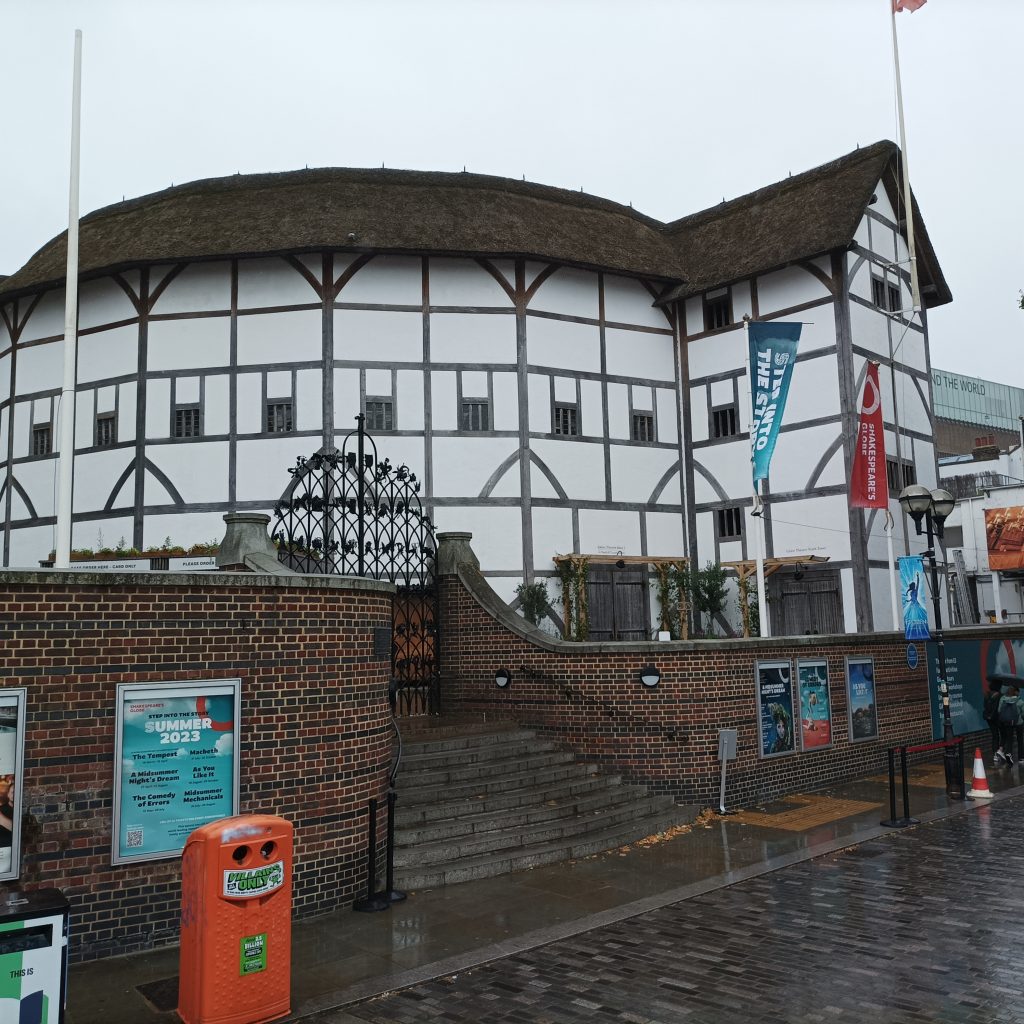
Shakespeare’s Globe Theater
In the case of Globe, the third was lucky, although it had to wait a long time. The idea of rebuilding the Globe as a tribute to Shakespeare had existed for centuries, but it was only in the 20th century that it became a reality. American actor and director Sam Wanamaker was the main initiator of the project. After decades of planning and research, the reconstruction of the theater began in 1987, and construction was completed in 1997. It was built using techniques and materials that were available in Shakespeare’s time, to be as faithful as possible to the original. It has an open roof and is located around the central stage, just like in the Elizabethan era, and today it serves as a performance space, but also as an educational center dedicated to the study of Shakespeare’s life and works, with the fact that, in addition to performances, it is also possible to visit a tourist tour.
As luck would have it, during my visit to London the repertoire included A Midsummer Night’s Dream and Macbeth. As Macbeth clashed with the schedule, the decision fell on a comedy and I have to say that I truly have no regrets. The whole experience is truly fantastic, the actors on several occasions consciously break the barrier between themselves and the audience, while the supporting choir (jazz ensemble) faithfully follows the drama of their reactions. The ending was cathartic, almost dreamlike – just as Puck (Malik in Croatian) explained at the end of the comedy. Along with the tickets, which are for standing inside the ‘parterre’ and sitting in the stands, it is possible to rent a pillow so that our rear end do not suffer much during the performances, which can last up to three hours. There is not much to say here except – a warm recommendation.
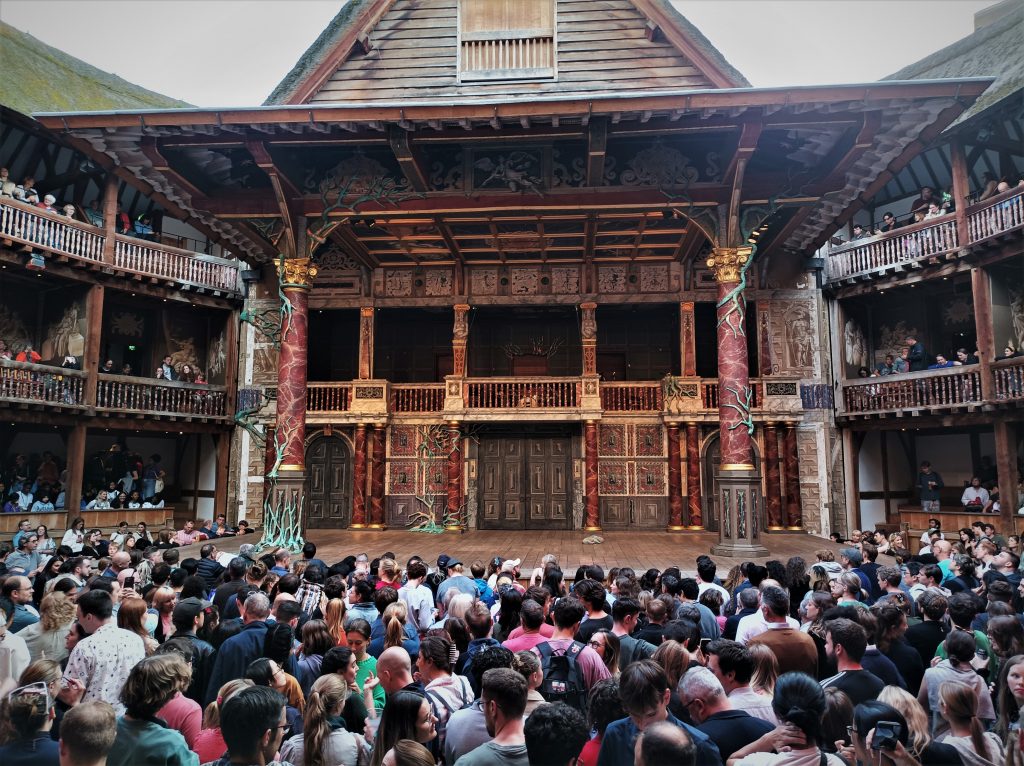
Shakespeare’s Globe Theater
Madame Tussauds
And while before visiting London I would have immediately concluded that Madame Tussauds (hereafter MT) is an ordinary museum that has wax figures instead of human figures, today I know I would be catastrophically wrong. I freely admit that MT was the experience I enjoyed the most in London. This museum, if we can call it like that and not a theme park, was named after the wax artist Marie Tussaud. She learned the craft from the Swiss doctor Phillipe Curtius, who was friends with many influential people of the 18th century, so the first figures she made were Voltaire, Jean-Jacques Rousseau, Benjamin Franklin, and others. In the chaotic years of revolutionary France, she was on the verge of the guillotine, but her life was saved by her acquaintance with Curtius, who, upon his death in 1794, left her his wax figures.
After the end of the chaos of the French Revolution, she and her husband moved to Britain, where in 1835 she finally began exhibiting her wax figures in a space near the current location. Over time, her museum became an attraction, and after her death, the enterprise was managed by her descendants. In the 20th century, the museum became a franchise, and to date, apart from London, it has a total of 23 other locations around the planet. London edition begins as a visit to an ordinary exhibition space where there are some kind of wax figures of athletes, actors, musicians, the royal family, and other celebrities, with whom people have a pathological need to take photos. This made me a little sad at first, but in the end, I relaxed and surrendered to the experience. And after that first part, a real roller coaster of experiences followed. Given that it would be somewhat of a spoiler if I recounted all the future experiences, here I will put a suitable disclaimer *SPOILER ALERT* if you want to experience MT in your way (i.e. if, like me, you thought that this was strictly a museum of wax figures).
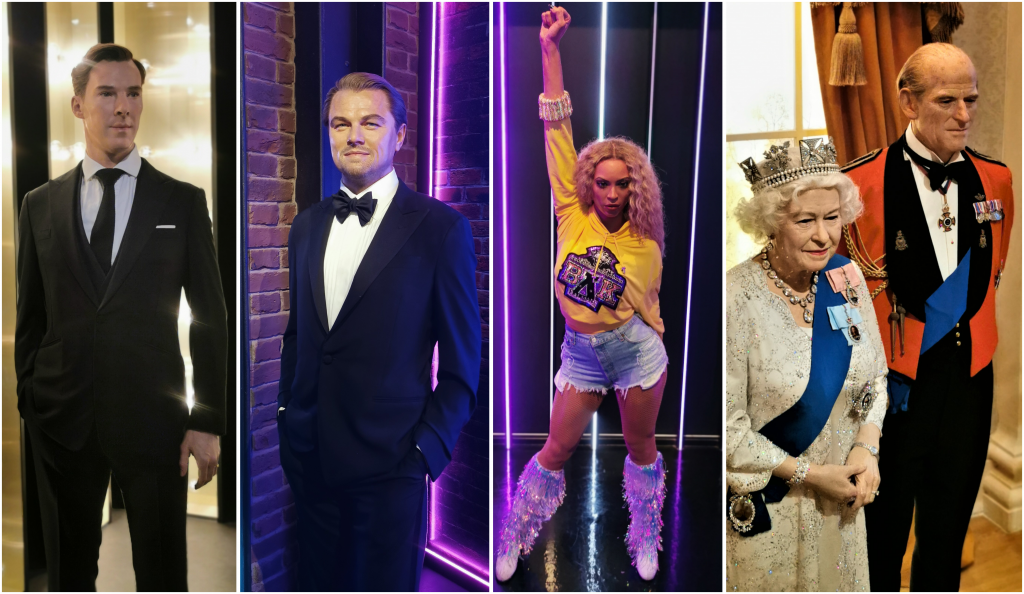
*SPOILER ALERT*
The next experience was the Chamber of Horrors, a display of notorious murderers, gangsters (the Kray twins), and serial killers (Jack the Ripper based on Aaron Kosminski, John Haigh, John Reginald Christie) from British history, suitably combined with scenes of the guillotine and the heads of the most famous victims of the French Revolution (Louis XVI, Marie Antoinette, Robespierre, Carrier and Hebert). An interesting addition is some moments that can quite surprise you when, after several galleries of wax figures, you meet a person who speaks to you the moment you approach them – and you don’t expect that from a wax doll. In addition, to better evoke the experience of Whitechapel during the Ripper’s murders, a special ‘myo-smell’ of urine was added to the room, which prevailed in the alleys of the troubled district. Over the years, the rooms of the Chamber of Horrors have been filled by individual figures from world history not always directly related to Britain, such as Vlad Dracula, Genghis Khan, Adolf Hitler, but also the most famous antagonist of the Gunpowder Plot, Guy Fawkes. From 2016 to 2022, this experience was briefly replaced by the Sherlock Holmes Experience, whose house (and museum) are relatively nearby on Baker Street.
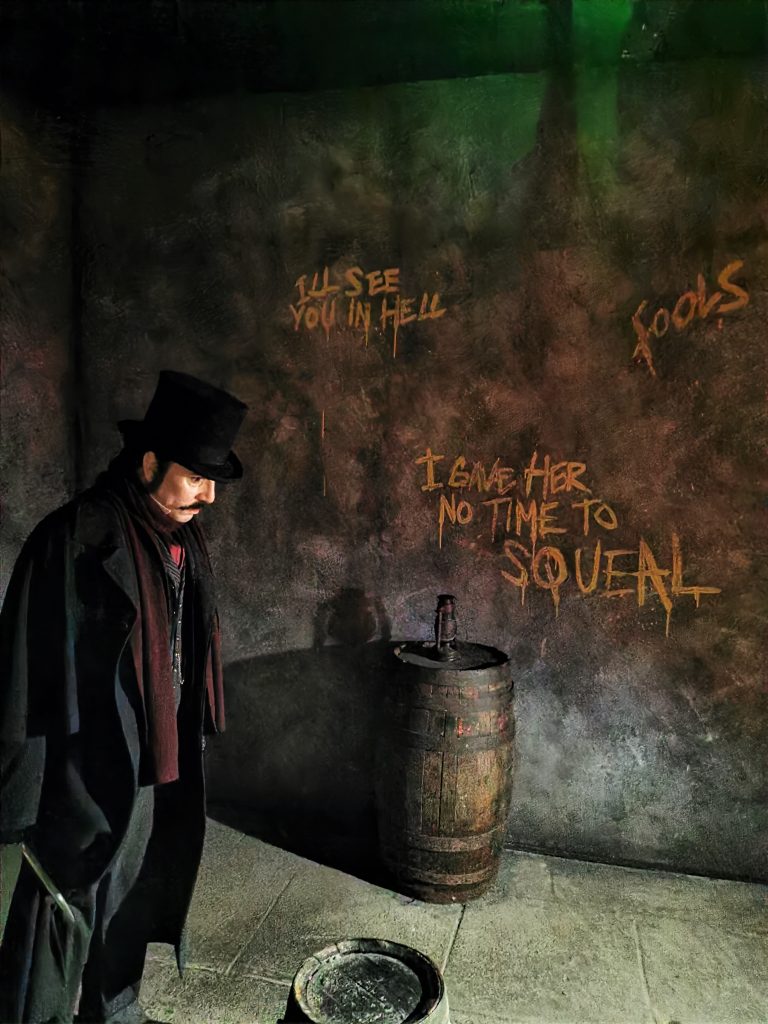
Jack the Ripper (based on Aaron Kosminski)
After that, another unexpected experience followed, and it was extremely endearing. We went through The Spirit of London, a ride through the history of London: from Tudor England, through the Elizabethan and Shakespearean theater eras, Oliver Cromwell and the Civil War, the Great Plague in 1665, and the Great Fire a year later, the time of scientific discoveries of Isaac Newton, Admiral Nelson’s triumph over Napoleon at Trafalgar, all the way to the Victorian era and the industrial revolution, Churchill’s war rallies during the Nazi bombings, and finally the swinging sixties in Carnaby Street and the punk 80s. Short, but quite cute and sweet, especially if you don’t expect it and if you’re ignorant like me and don’t know that driving is an integral part of the experience that the museum highlights on its pages.
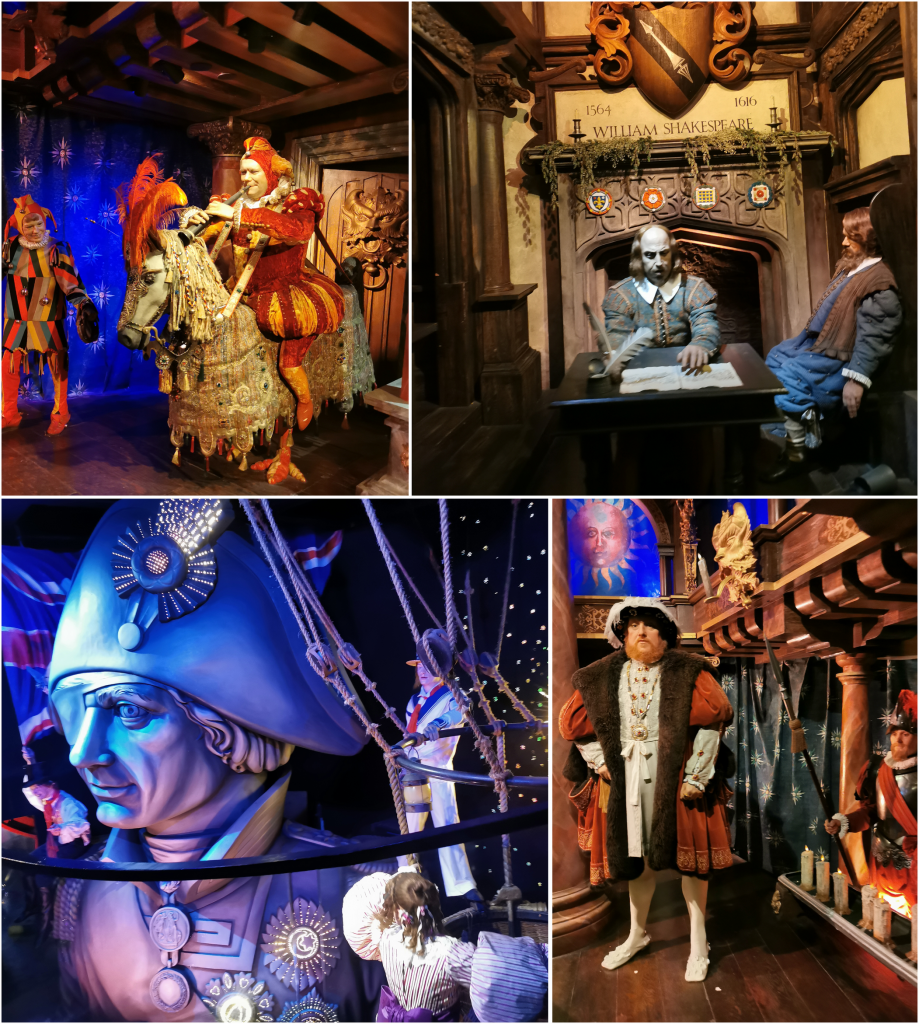
The Spirit of London ride
Another neat part followed, and that is the part dedicated to Marvel. Although not a huge fan, to whom figures of Spider-Man, Hulk, Hawkey, and Captain America do not mean much, I genuinely enjoyed the 10-minute film Marvel Super Heroes 4D in which famous superheroes defend London in a true 4D cinematic experience.
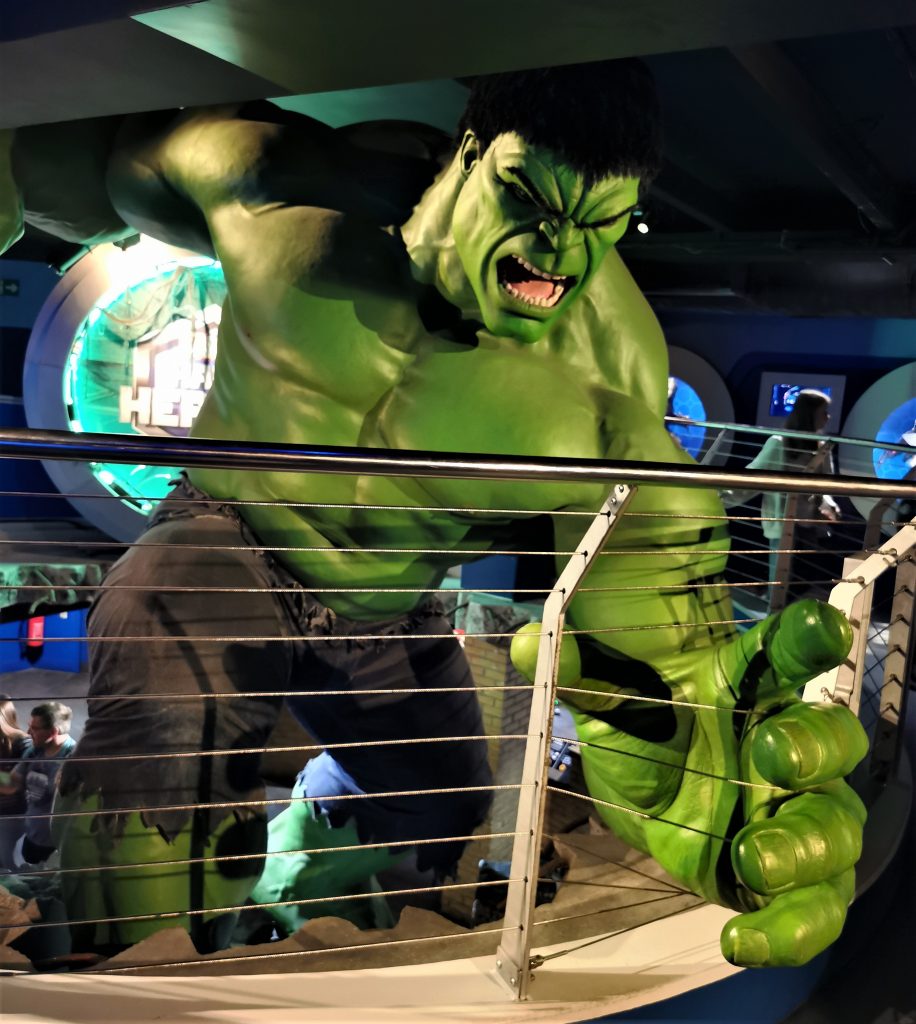
Finally, there was a visit to the Star Wars universe, where we could meet the vast majority of the most famous characters from the franchise in the settings that marked them within the SW franchise – the type of Darth Vader reaching out to Luke after the famous quote, Yoda in Dagobah where he revealed his power to Luke and origins, then Han Solo we meet in the cantina on Mos Eisley, Anakin as a possessed Sith at the moment of transformation, Leia in captivity with Jabba the Hutt, etc.
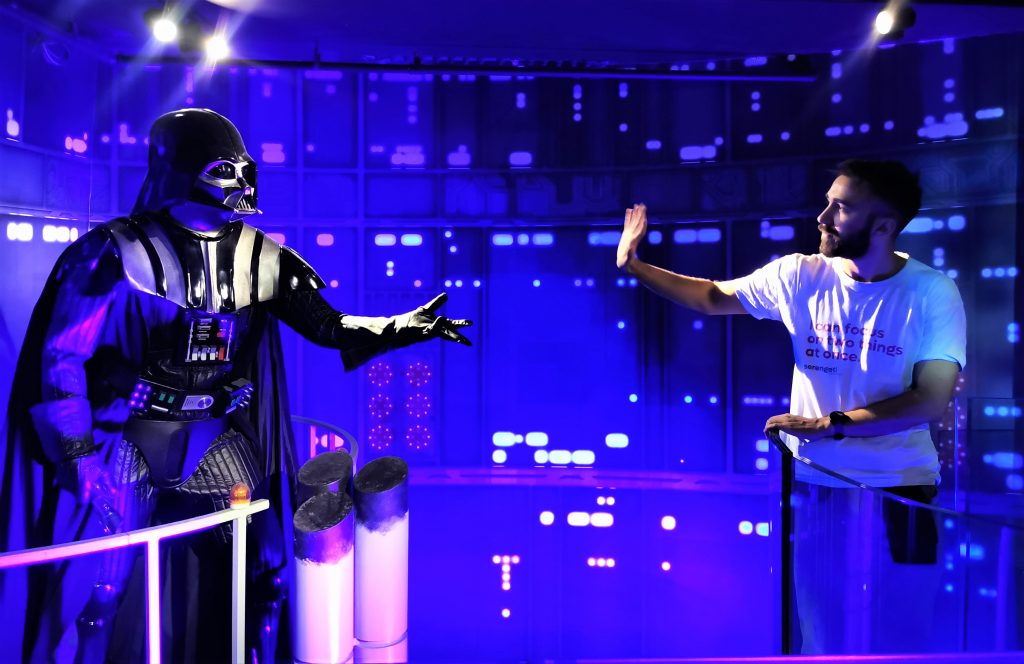
Either way, there’s something for everyone inside MT, which turned out to be a well-rounded experience beyond all expectations.
Fever
For those who want a bit more immersive entertainment and a mix of art with VR (virtual reality) simulations, the company Fever in London (and 100 other cities in the world) brings two masterful events. By the way, Fever is a company that has developed technology that offers personalized experiences for people in many cities, working with entertainment and event creators to improve audience user experiences. Two of the events that we visited in London were Dali: Cybernetics and Van Gogh: The Immersive Experience.
Dali: Cybernetics
And while it is difficult to say more about the crazy, insanely brilliant Catalan surrealist Salvador Dali, what is perhaps not so clearly known is that he was a big fan of technological innovations – he believed that computers were the future, he was among the first artists to collaborate with IT experts and he was interested in digital simulations, pixels and binary codes. Cybernetics corresponds to this knowledge, and new technology such as VR, or any level of shifted/augmented reality, enters the framework of Dali’s mini-mundus.

As a person who has been to Dali’s exhibition, who has seen many of his works in Madrid, Vienna, Paris, and London (I guess I only have the famous Figueres left), and who experienced an even greater space of immersion and projected works of Dali in the Parisian Atelier des Lumières (with the addition of Antonio Gaudí), I was interested in what Fever’s experience would bring me. While the exhibition itself was similar to what we had already seen, with the novelty of adding 3D glasses for parts of the projection with familiar motifs of Dali’s paintings (clocks, elephants, horses, atomic particles), VR was a complete hit. On a quasi-floating ship, we had the opportunity to immerse ourselves in the world of Dali’s voids, wastelands, deserts, and other liminal spaces filled with phantasmagorical dreams of his subconscious with the possibility of moving around the ship, playing on parts of the ship and admiring the moment. All in all, a great experience that I would recommend to anyone.
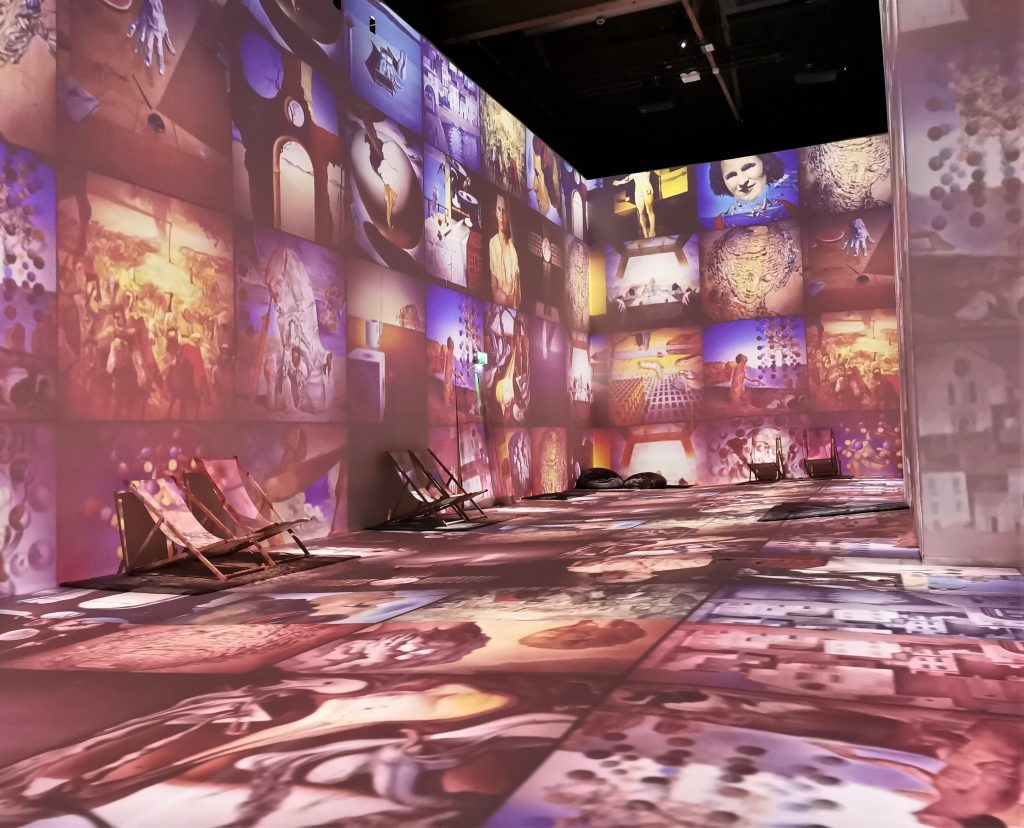
Van Gogh: The Immersive Experience
The day after Dali, we visited an immersive exhibition of Vincent van Gogh, an artist whose works I also stalked in European museums and whose museum I visited in 2019 in Amsterdam. Although this experience was equally interesting, in terms of immersion (especially a certain scene with a train that seems to be heading towards the visitors), the VR part this time was more static, not to say weaker. We were equipped with a headset and within 10 minutes we had the opportunity to ‘walk’ through the ambiance of Van Gogh’s most famous works (The Yellow House, Café Terrace, The Night Café, Bedroom in Arles, Starry Night Over the Rhône, variants of Wheatfields, with crows and with peasants, etc.) and his self-portraits. An interesting experience, but Dali’s surrealism has more value for this type of experience.
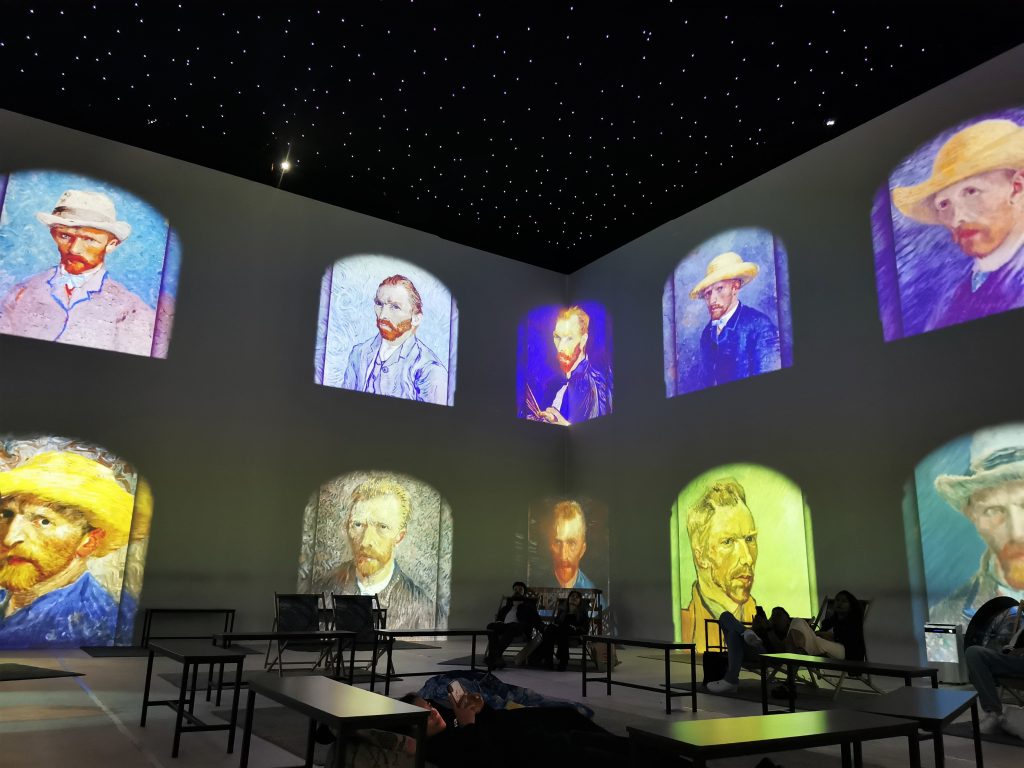
Nevertheless, Van Gogh’s experience is something that spreads the word about immersive experiences as such, which is why today there are numerous providers of the same experience. My advice is to be careful and choose proven ones – with Fever you won’t miss.
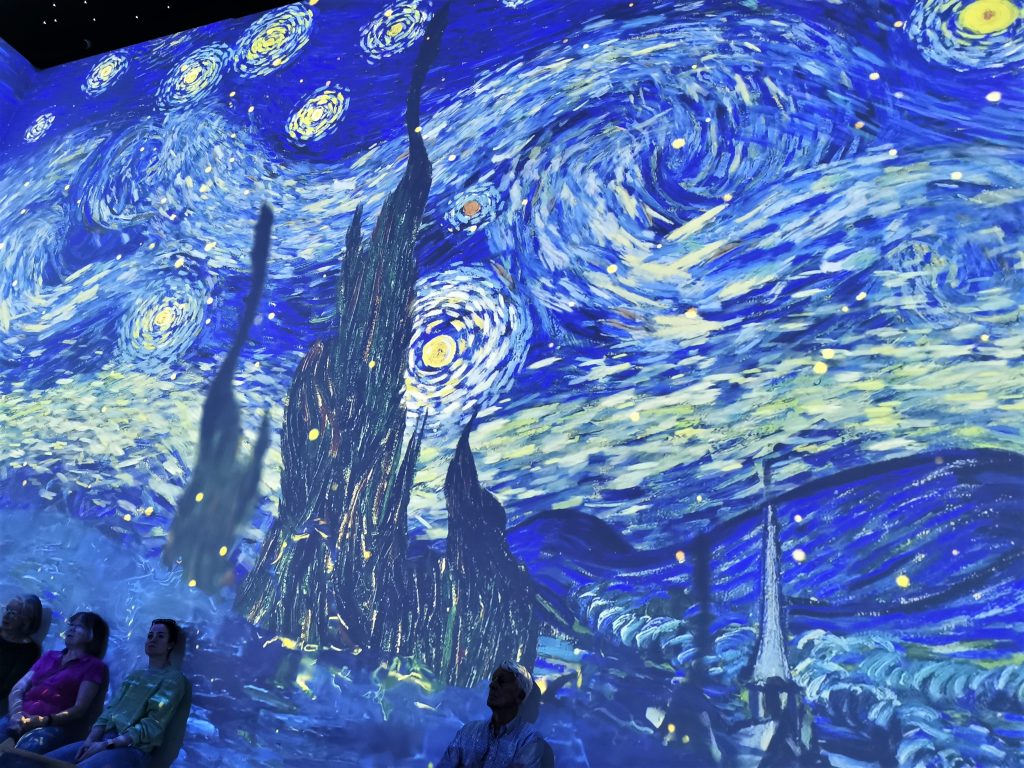
Jack the Ripper tour
During one part of the London trip, the accommodation was in Whitechapel, a part of London made notorious for ‘operations’ of Jack the Ripper in 1888, the greatest enigma in the history of serial killers. Although I had some prior knowledge about the Ripper and the whole case, going on a tour organized by the oldest tour operators on this topic seemed like a good idea.
As a guide, we had likeable Jeremy, a historian who earns his living by leading these tours. Within two hours, all present people in the tour could pass through a series of historic streets, stop by the sites that are important for the forensics of the whole case, and walk through the locations where the bodies of the unfortunate victims were found (not all, because some parts were simply demolished or repurposed), with ambient additions such as the simulated smell of urine to evoke the dereliction of Victorian Whitechapel, as a poorer part of London.
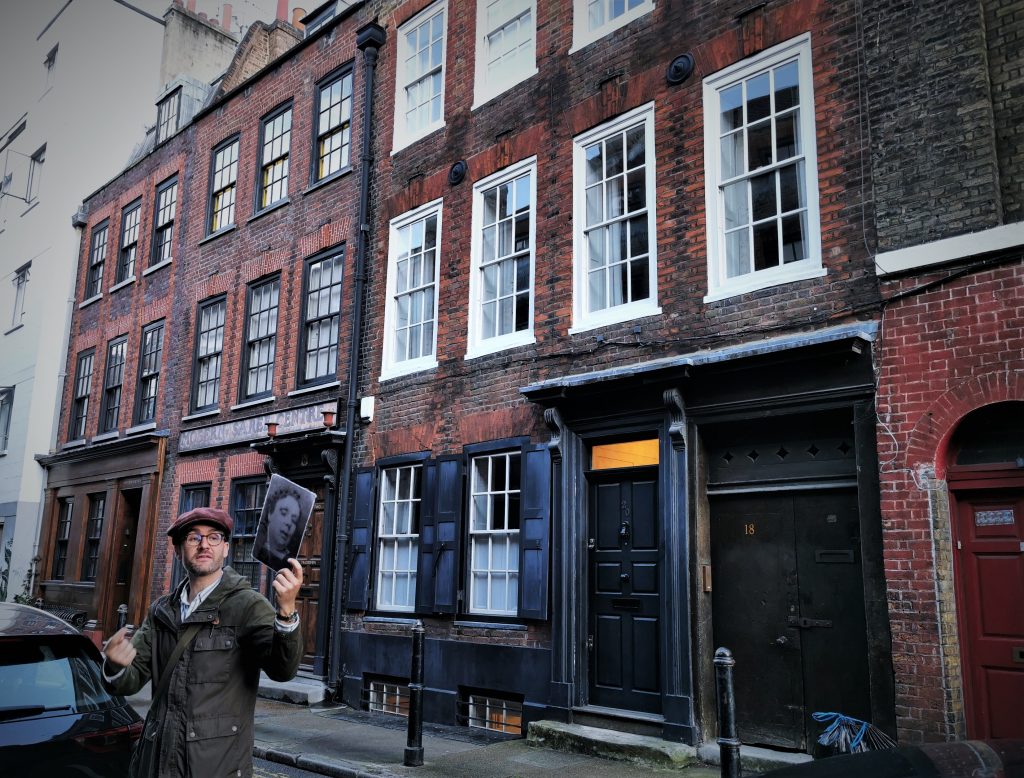
What is interesting about this tour, in contrast to the general frenzy for the identity of the perpetrator that has been puzzling many (Internet) detectives for 130 years and more, is the focus on the victims and the attempt to portray their ‘condition’ and to dispel the myth of their ‘trade of prostitutes’. In any case, a recommendation for people looking for a dose of chills is when you connect the brutal events that happened in the dead of night with the locations you are passing by.
Barbican Centre
The Barbican is one of the largest cultural centers in Europe and is an outstanding example of Brutalist architecture. It is located in the City of London, the historic core of the city. After the Second World War left a large part of this area in ruins, reconstruction and conversion were considered, so that the Barbican was finally opened in 1982.
In its offer, The Barbican offers numerous cultural events, manifestations, exhibitions, and concerts, and within the center, there are:
- Barbican Hall: The main concert hall with a capacity for more than 1,900 visitors, where the London Symphony Orchestra performs
- Barbican Theatre: Theater with more than 1,100 seats
- Barbican Art Gallery and The Curve: Spaces dedicated to visual art
- Barbican Cinema: Complex with three cinema halls
- Barbican Library: One of the main libraries of the City of London zone conference rooms and classrooms
Our reason for visiting the Barbican was a concert by the famous jazzer Herbie Hancock, and you can read the report from that concert here.
London Zoo
For the purpose of this article, we will put aside any ethical questions surrounding the need for zoos to exist. The fact is that they exist and that their basic intention is, we hope, the welfare of animal species. The London Zoo is the third oldest in the world – it was founded in 1828, and with it the Zoological Society of London, which opened it to the public in 1848.
It is divided into three zones – orange, blue, and pink and is home to approximately 650 animal species. Within these zones, there are specialized zones for individual animal species – Monkey Valley and In with the Monkey, for monkeys, of course. The Into Africa section is intended for zebras and pygmy hippos. Gorilla Kingdom is home to a family of gorillas, as one of the zoo’s attractions, just like Sumatran tigers in Tiger Territory and lions in Land of the Lions, a part that seems to be a copy of the Indian reserve/Gir National Park from where they were brought.
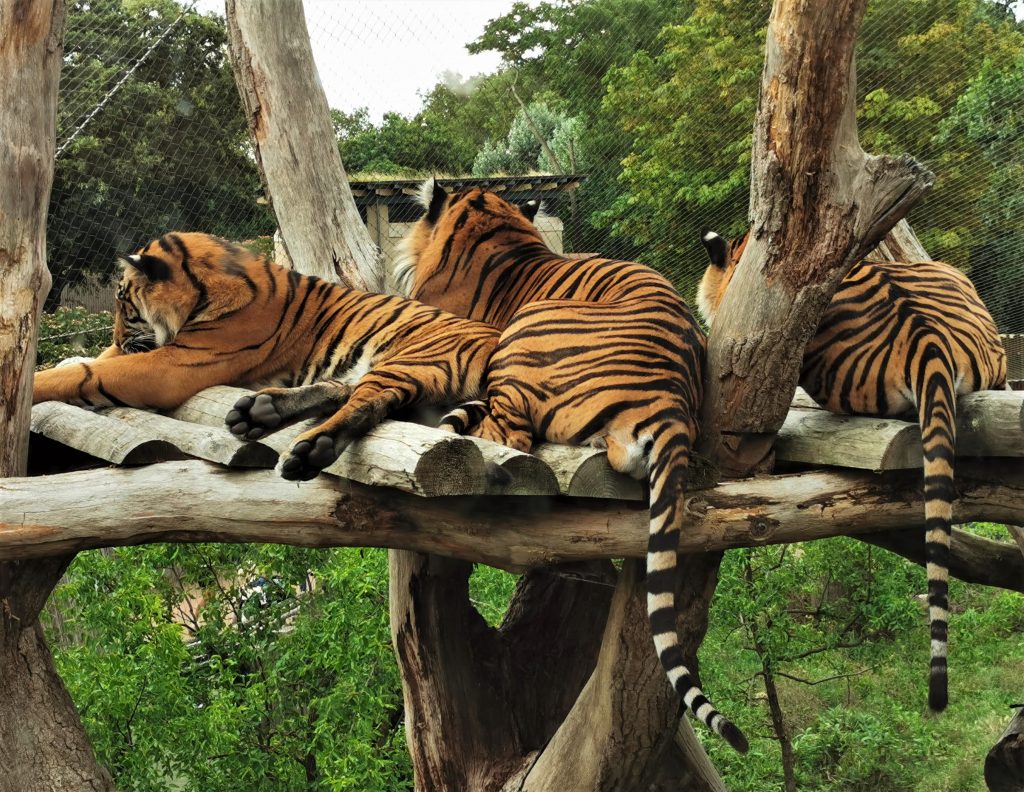
Penguin Beach is also worth highlighting, followed by the Butterfly Garden with an abundance of different types of butterflies; Tiny Giants is a place for numerous insects, scorpions, snails, and spiders, where there is even a kind of open walkthrough among spiders In with the Spiders, and within the museum there is a program to combat arachnophobia. Unfortunately, during our visit, the Reptile House with several species of frogs, snakes, and crocodiles was in the process of being moved to the new location of the Secret Life of Reptiles and Amphibians, which is opening soon, so only some species were in place; next to the current reptile house is the Komodo Dragon House for the Komodo dragon, opened with the help of Sir David Attenborough.
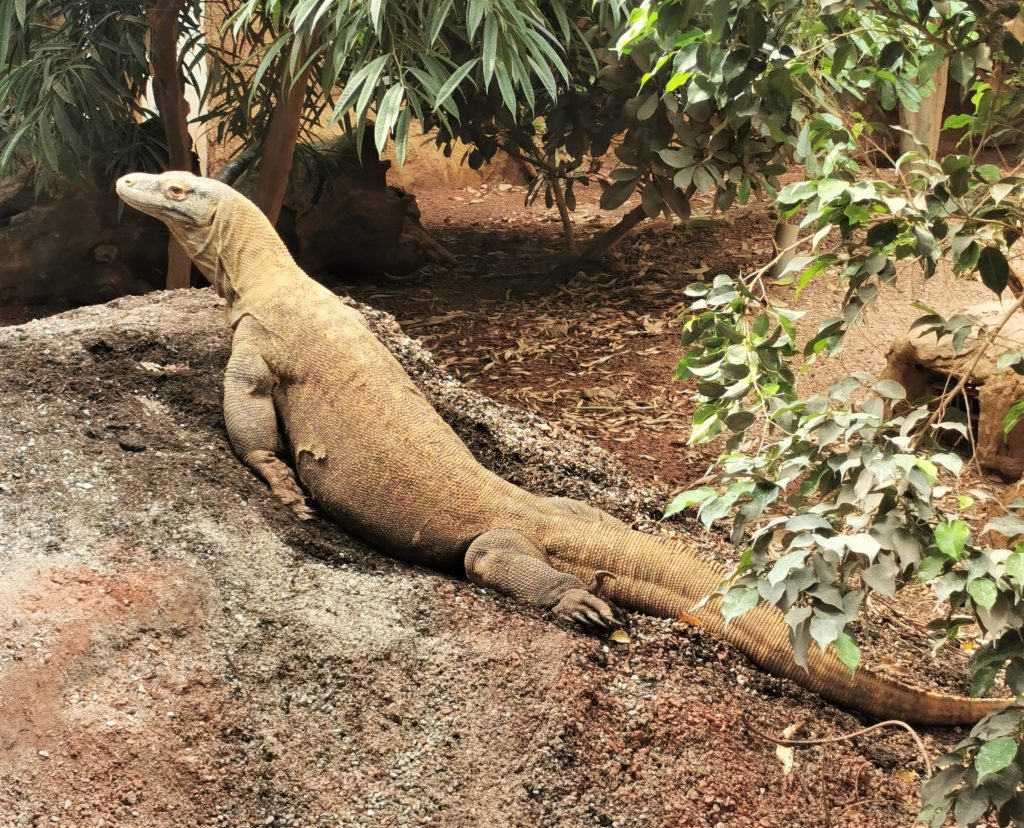
All in all, an interesting visit and encounter with certain species that I could otherwise only watch in Attenborough’s series or National Geographic, the Zoo also has numerous lectures, events, and content for children and the wider community, as well as sanitary facilities, restaurants, charging stations for devices, lockers for luggage, and in addition to all that, it is well connected to the city.
Royal Greenwich Observatory (RGO)
The Royal Observatory in Greenwich was founded in 1675, and its purpose was the development and research of astronomical science. From its very foundation, it was a place of astronomical research and experiments, and it played an important role in the cataloging of stars and the observation and recording of solar and lunar phenomena. The observatory as an institution played an important role in the development of precise navigation, in the development of methods for determining latitude and longitude at sea, which was of vital importance for the development of the British navy and trade, as well as the standardization of the concept of time, which will be discussed later.
Today, the observatory itself is more of a tourist attraction and institution under UNESCO protection, since the activities of the RGO were relocated in the 90s. The complex, of course, also has a distinct educational note, since it contains a mini-exhibition on the concept of time throughout history, exhibition halls that show the history of astronomy, time measurement, and the importance of the zero meridian, and also hosts a series of innovative instruments, former techniques, large telescopes, precise chronometers and clocks, globes, model maps, and other artifacts.
One of the most famous aspects of RGO is the Greenwich Meridian (Prime Meridian). It is the reference line for Earth’s 0° latitude and is used as the starting point for measuring time (Greenwich Mean Time or GMT) as well as for coordinating time zones around the world. All this stems from the International Meridian Conference – it was held in 1884 in Washington to standardize the global time system and select the main (zero) meridian around which world time would be based. This conference was a response to the need to coordinate railway and maritime schedules, as well as other international activities.
At the conference, it was decided that the meridian in Greenwich would be the official prime meridian of the world. One of the reasons for this decision was that, at the time, more than two-thirds of all ships were already using charts based on Greenwich as a reference point. As a result of the standardization of time, the world is divided into 24 time zones, each 15° wide and long. Each time zone represents one hour, with Greenwich as the reference point for GMT. One of the attractions of the entire complex is the zero meridian line where tourists pose with their feet on both sides of the earth’s hemisphere.
There are several buildings within the complex:
- Flamsteed House: Named after the first Astronomer Royal, John Flamsteed, this building is the oldest part of the observatory. It contains Flamsteed’s original residential wing, as well as the Octagon Room, which is one of the most beautiful rooms in the observatory, with original astronomical instruments. How important the role of the Astronomer Royal was is shown by the fact that it still exists today, as if the second in line in that position was the famous astronomer and mathematician Edmond Halley, after whom he was named the most famous among comets (among all other achievements in the field).
- Telescope domes: The observatory has several telescope domes, including the large equatorial dome that once housed one of the largest telescopes in the world.
- Peter Harrison Planetarium: The UK’s most modern planetarium, where visitors can learn about the starry sky and space through immersive visual projections.
As part of a visit to the observatory, one can participate for an additional fee in one of the impressive projections in the planetarium. My choice on this trip was the Moonbase projection: Since mankind first stepped on the moon, which we can learn more about in the introduction (about the start of the space race and its progress), one of the main intentions of mankind has been to explore the possibility of interplanetary travel and to create a foothold on month, where we would draw water and minerals, grow food, start families and live permanently.
However, the still not-so-easily achievable obstacles are the distance of almost 400 thousand kilometers, surviving the hostile, alien conditions of reduced gravity, extreme temperatures, particles of toxic moon dust, and the mineral that mainly makes up the surface of the moon, regalite, which is extremely sharp and abrasive and can penetrate the protection of astronaut suits. Nevertheless, the projection ends with a dose of optimism that sees living on the moon as a real possibility, just as prominent sci-fi writers, futurologists, and aviation engineers predicted. The only question that remains is which generation will experience it.
All in all, going to Greenwich is interesting for several reasons – a visit to the observatory complex and a wonderful view of the city, then the National Maritime Museum, the Wolfe statue, but also because of the colorful Greenwich Market, the Cutty Shark sailing ship or the interesting but somewhat claustrophobic experience of passing through the tunnel under the Thames.
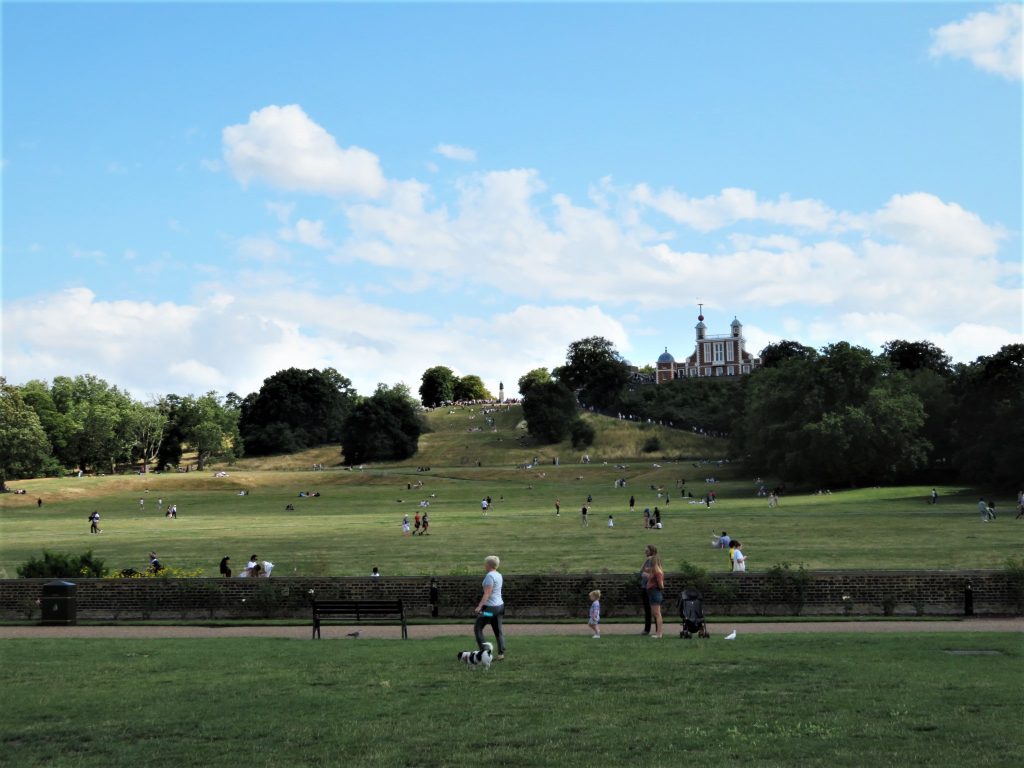
Royal Greenwich Observatory
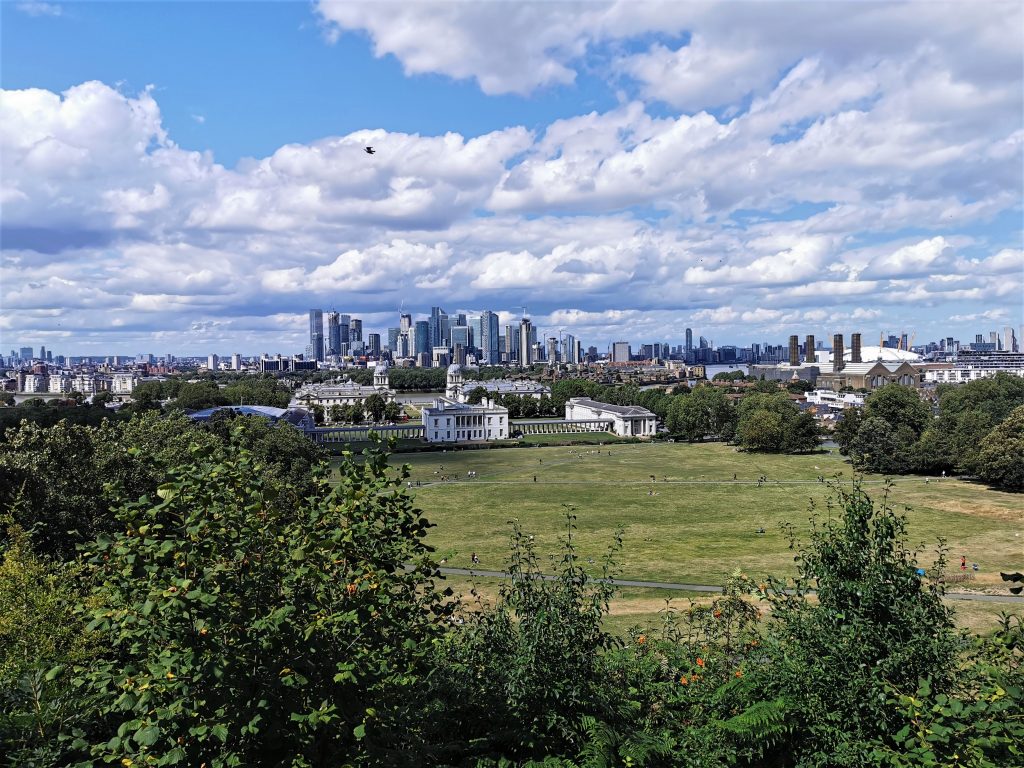
View from Royal Greenwich Observatory
National Maritime Museum
The largest museum of its kind in the world, the National Maritime Museum is located in Greenwich, in symbiosis with the Royal Observatory, the planetarium, and the Cutty Shark sailing ship. As the British throughout their long and rich history were the greatest maritime power in the world with a huge navy that served for trade, wars, and colonial efforts, it is not surprising that such a museum, with a large number of exhibits and various permanent exhibitions, is located in London. Given that it is free, it is visited by a huge number of people every year, and it is also suitable for the youngest visitors. It is worth highlighting a few permanent exhibitions:
- Nelson, Navy, Nation – through one of the most famous British victories over Napoleon in the Battle of Trafalgar in 1805, the life, character, and work, but also the tragic death in the same battle, of Admiral Horatio Nelson are celebrated – whose personal belongings (bloody uniform from the battle) are presented in this section. At the same time, the importance of the navy for the maintenance of world domination is discussed and it is clarified what the navy, as a respected military service, has meant over the years. This theme is followed by the smaller exhibition Turner’s Battle of Trafalgar, where the largest painting by the respected British landscape and sea painter, J. M. W. Turner – a depiction of the famous battle – is exhibited.
- Tudor and Stuart Seafarers – Although the Spanish, Portuguese, and Dutch initially had a more developed navy, the British were not far behind in the very beginnings of exploring new worlds thanks to John Cabot‘s expeditions. In this part, the beginnings of research by famous navigators (Cristoforo Columbo, Amerigo Vespucci, Vasco da Gama, Bartolomeo Dias) are shown, but also phenomena such as the slave trade from Africa (in which the British, led by John Hawkins, soon took over the primacy), trade and piracy, all of which can be studied on interactive maps. Also covered are the Spanish Armada and the invasion of Britain in 1588, the wars with the Dutch, and, in general, adventures involving ambition, power, wealth, and conflict through the early years of exploratory expeditions and the struggle for naval supremacy.
- Traders: the East India Company & Asia – This extremely interesting gallery focuses on the birth of the East India Company, a company founded for the purpose of the spice trade, which soon became so powerful and influential that it became a real state within a state and was the most famous proponent of British imperialism. At one time, it was considered the largest and most powerful company in the world, along with its Dutch counterpart of the same name, and over the years it was involved in numerous scandals, coups, wars, and affairs, such as drug trafficking, which eventually led to wars with China, but also to the loss of Company influence and its shutdown after the Indian rebellion in 1857.
- Polar Worlds – This exhibition focuses on the centuries-old British efforts to find a passage between Canada and the Arctic, so it mainly touches on the natives of the northern Canadian climate (Inuit) and thematizes the infamous expedition of Sir John Franklin and the accident of his ships, Terror and Erebus in 1845.
- Pacific Encounters – part of this gallery refers to the exploration of the Pacific, the world’s largest ocean, and encounters between the British and natives from the South Pacific Islands, Australia, New Zealand, and Hawaii. The focus is, of course, on James Cook‘s famous Pacific expeditions and his death on one of them. One part deals with British colonialism, which inevitably led to conflicts with indigenous peoples on many occasions, and thematizes the complex historical interrelationship and customs of people from this climate, often in collision with ‘civilized’ colonizers.
- Maritime London – the importance of shipping and the Thames with the transformation of London into an international financial and commercial center of the world throughout the centuries.
- Forgotten Fighters – a presentation of individual fates of soldiers and sailors who participated in the First World War.
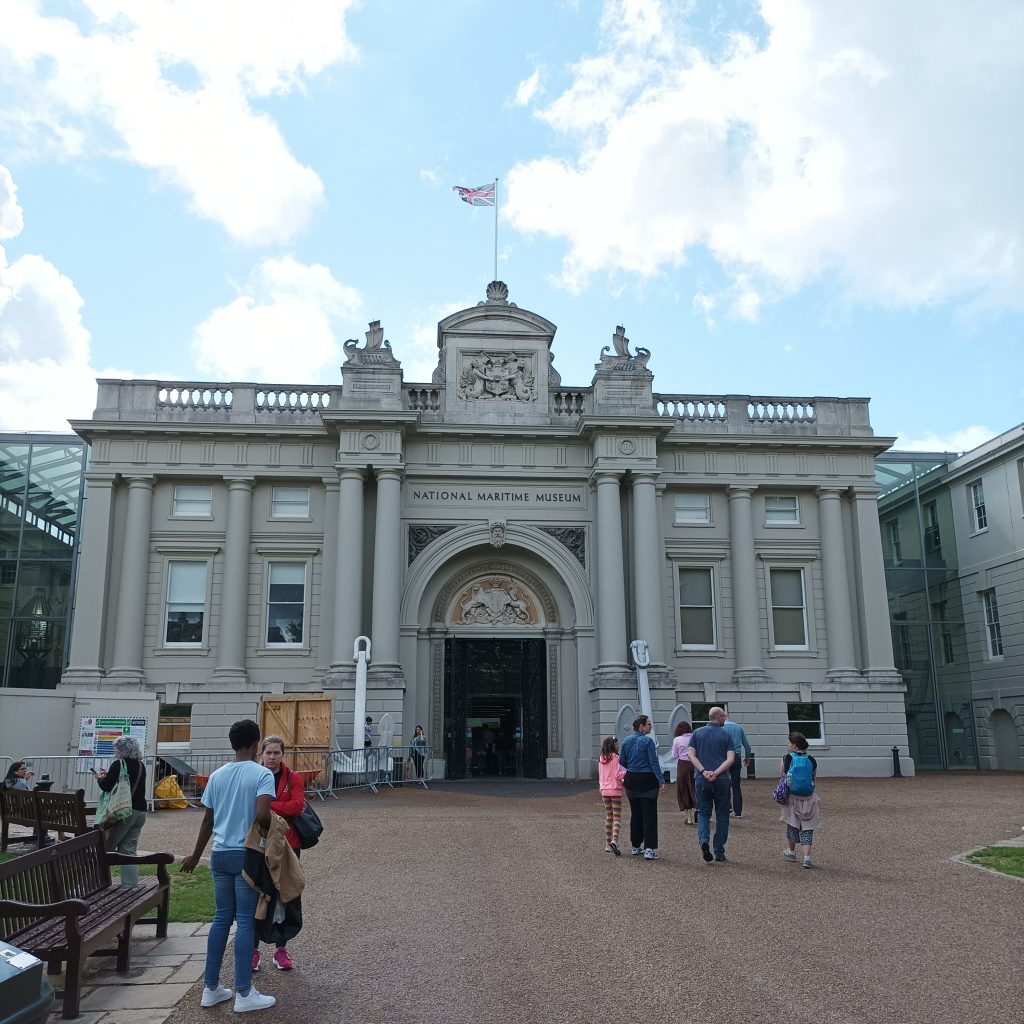
National Maritime Museum
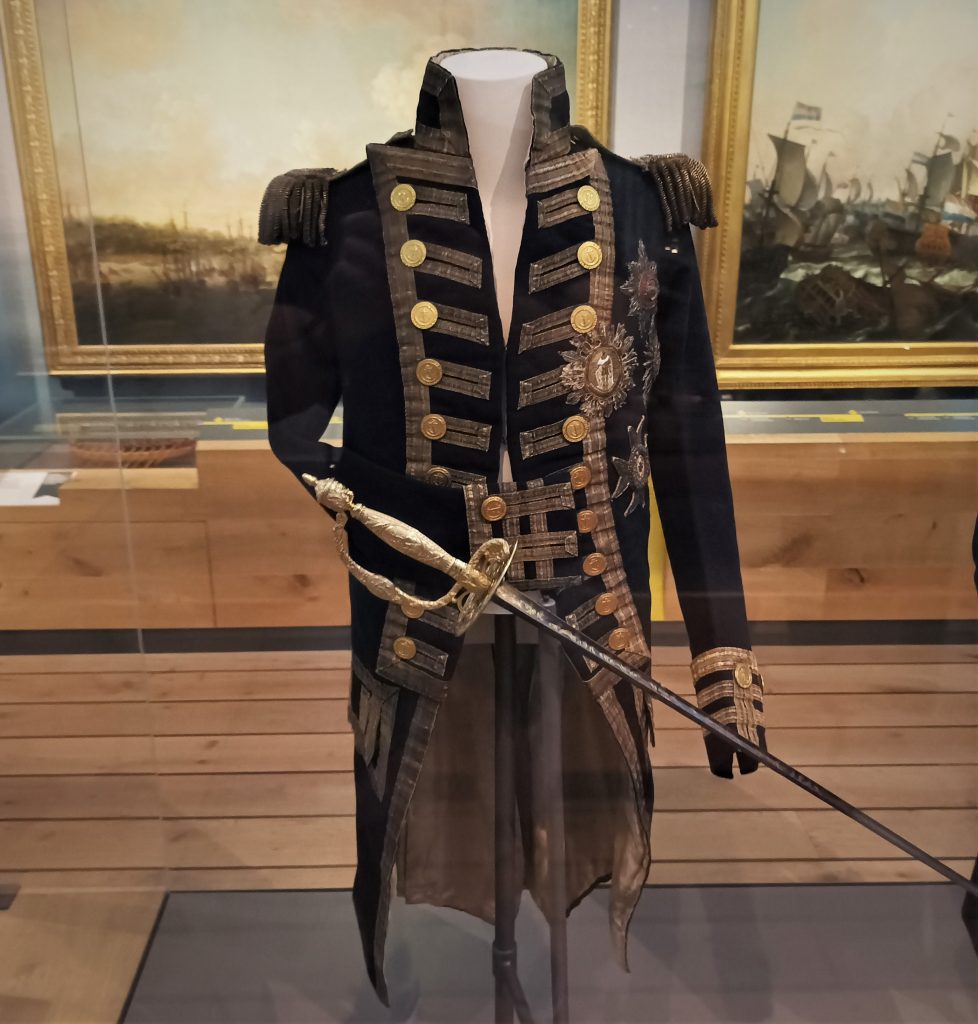
Nelson’s Trafalgar coat
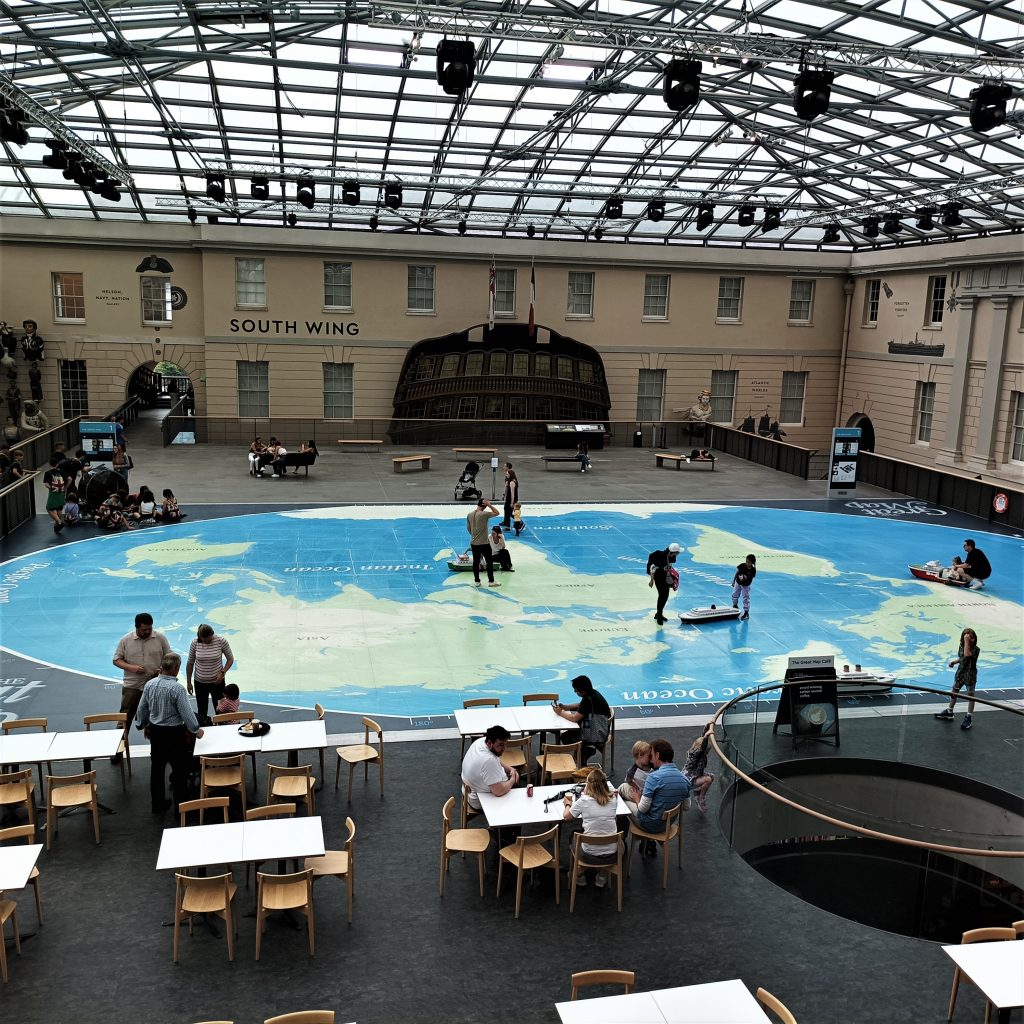
National Maritime Museum
British Museum
The British Museum, the fourth most visited and one of the largest museums in the world was founded in 1753. The original need for the establishment came to facilitate the protection and preservation of various objects, antiques, and cultural and artistic objects from all possible climates that the British colonial hand extended over the centuries. It is for this reason that the museum is the subject of controversy, which is why it is associated with the restitution of cultural goods, transferred and alienated from other countries during the colonial rule of the British over certain areas.
Its collections include countless Egyptian artifacts, treasures from Assyria, Babylon, and the rest of Mesopotamia, ancient Greek and Roman sculptures, Asian (emphasis on China, India, and Japan) and African (Benin, Nigeria) art, then Central American cultures (Olmecs, Aztecs), oriental collections, ethnographic and many other items in the collection that contains more than eight million objects, of which only 1% (about 80 thousand) is on display.
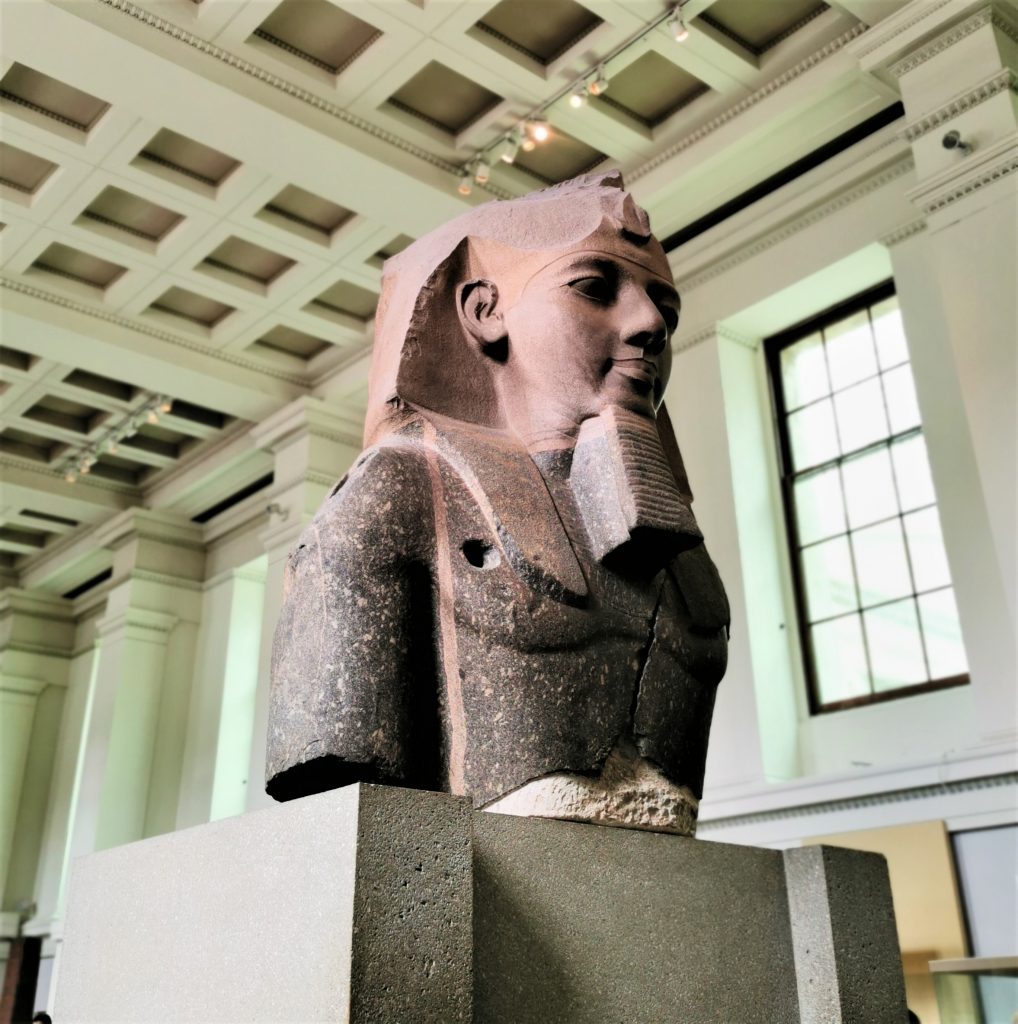
Today it is a vital representation of the world’s cultures throughout history, as its collection includes objects from almost every part of the world, making it one of the most important places for the study of the world’s general cultural heritage. It represents a valuable resource for the study of world history and archaeology, culture, and art, and it is visited every year by millions of tourists and lovers of all kinds of historical materials.
Some of the most valuable exhibits are the Rosetta Stone, the key to deciphering hieroglyphs, the Elgin Marbles and the marble statues of the Parthenon in Athens, the Paraclete statues from Ostrac, the Olmec stone head, reliefs depicting Assyrian lion hunters, the Golden Mantle from the Bronze Age, the Lewis medieval chess pieces, the helmet from Sutton Hoo, a bronze sculpture of Shiva, figures from the Tang Dynasty, an Islamic Astrolabe, an Oxus treasure from the climate of Persia, and more.
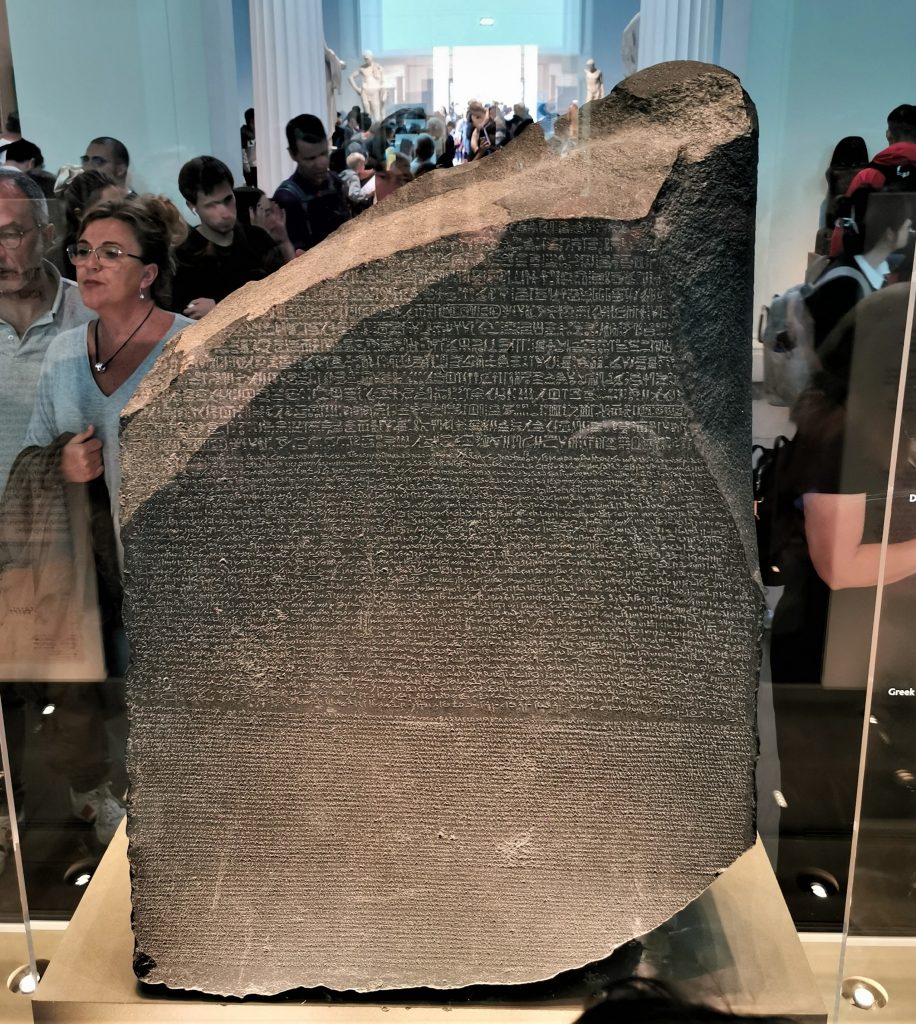
Rosetta Stone
During our visit, there were two interesting exhibitions, for which tickets are charged separately:
- Luxury and Power – Persia to Greece: When Greek soldiers captured the royal command tent of the Persian king during the Greco-Persian Wars (499-449 BC), they were confronted with luxury on an unimaginable scale. For many ancient Greek writers, the victories of the small Greek forces against the mighty Persians were a triumph of discipline and restraint over an empire weakened by decadence and excess. This exhibition is set up to explore the more complex story of luxury as a political tool in the Middle East and Southeast Europe. It shows how the Achaemenid royal court in Persia used precious objects as a sign of authority and power, defining a style of luxury that reverberated throughout the empire, from Egypt to India. The exhibition shows how Eastern luxuries were embraced in early democratic Athens, which self-styled as Persia’s arch-enemy, and how the same objects were adapted in innovative ways to make them socially and politically acceptable. Finally, we come to how Alexander the Great destroyed the Persian Empire and ushered in a new, Hellenistic age in which Eastern and Western styles of luxury merged as part of an increasingly connected world.
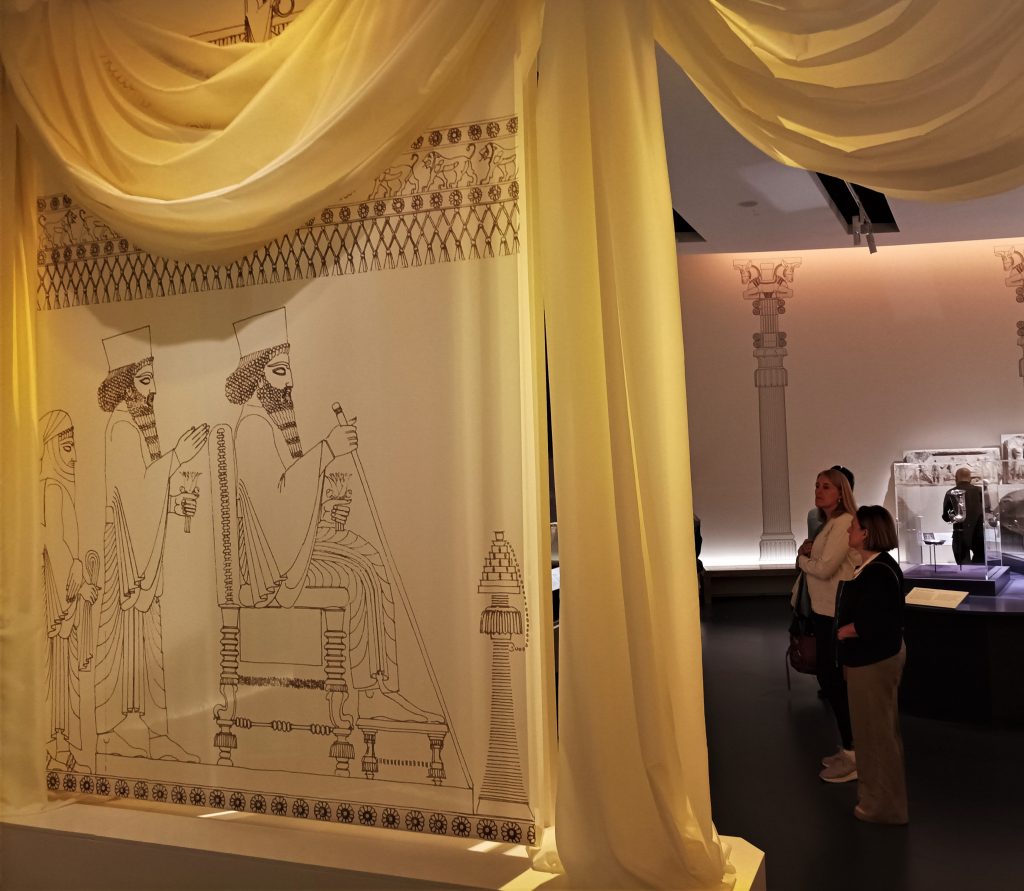
Luxury and Power – Persia to Greece
- China’s Hidden Century: Between 1796 and 1912, China’s Qing Dynasty suffered numerous, extremely bloody civil rebellions (the Taiping Rebellion, one of the bloodiest conflicts in human history) and foreign wars, with the revolution finally ending around 2,000 years of dynastic rule and gave way to the modern Republic of China. This period of violence and unrest was also a period of extraordinary creativity, fueled by political, cultural, and technological change. In the shadow of these events lie the stories of individuals – at court, in armies, and in cosmopolitan cities on the rise and the global scene.
Many objects have been brought together for the first time – from the cloisonné vases given to King George and Queen Mary by the court of the Last Emperor for their coronation in 1911 to the silk robe commissioned by the Empress Dowager Cixi. As stated, this exhibition illuminates the lives of individuals – an empress, a dancer, a soldier, an artist, a housewife, a merchant, and a diplomat. Visitors will have the opportunity to pay attention to the textures of life in 19th-century China through art, fashion, newspapers, furniture – and even soup ingredients. Many people have not only survived but thrived in this turbulent world. New art forms, such as photography and lithographic printing, flourished as technology and transportation—the telegraph, electricity, railroads—transformed society.
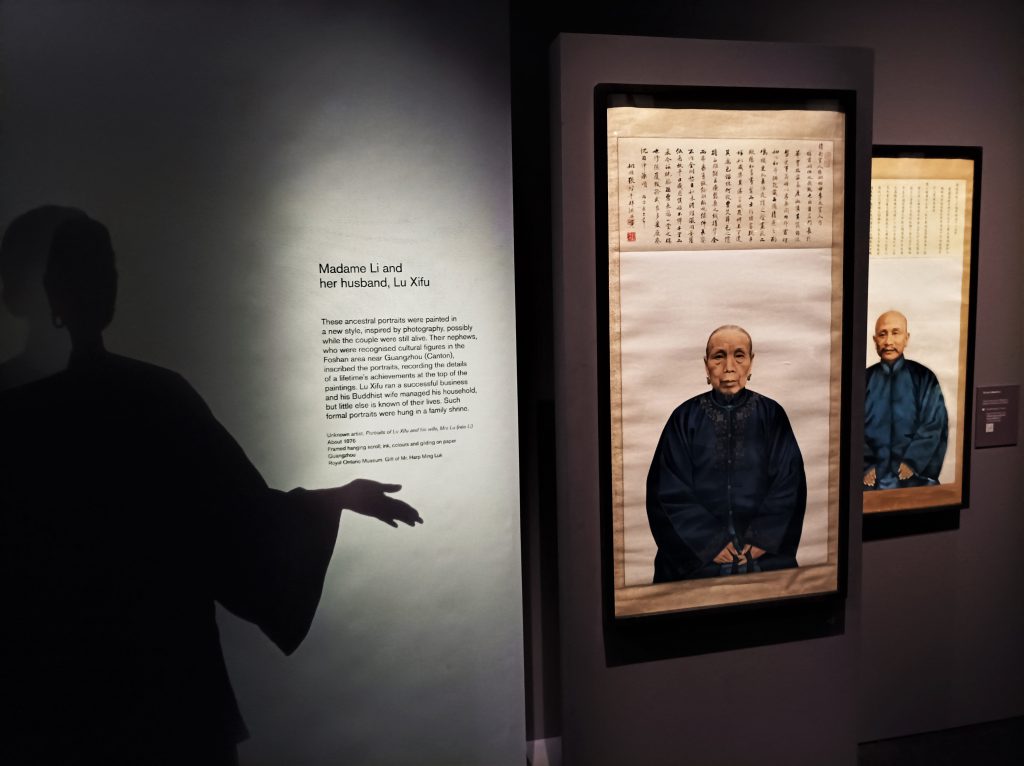
China’s Hidden Century
Science Museum
First of all, we visited the paid and extremely popular exhibition Science Fiction: Voyage to the Edge of Imagination. Guided by artificial intelligence of extraterrestrial origin through an immersive exhibition, we explored an unknown planet and how scientists and science fiction creators imagined and built new worlds to better understand our own. During this interactive journey, we came across authentic items and costumes from movies, TV shows, and books, as well as paintings, artwork, and photographs. As part of the exhibition, we could create our own dystopian story based on two templates – sea level rise or a major drought, find out what percentage of us are cyborgs through a sympathetic analysis of the use of robotic aids, and we could evaluate our optimism about the existence of intelligent levels of life in our galaxy through the Drake equation.
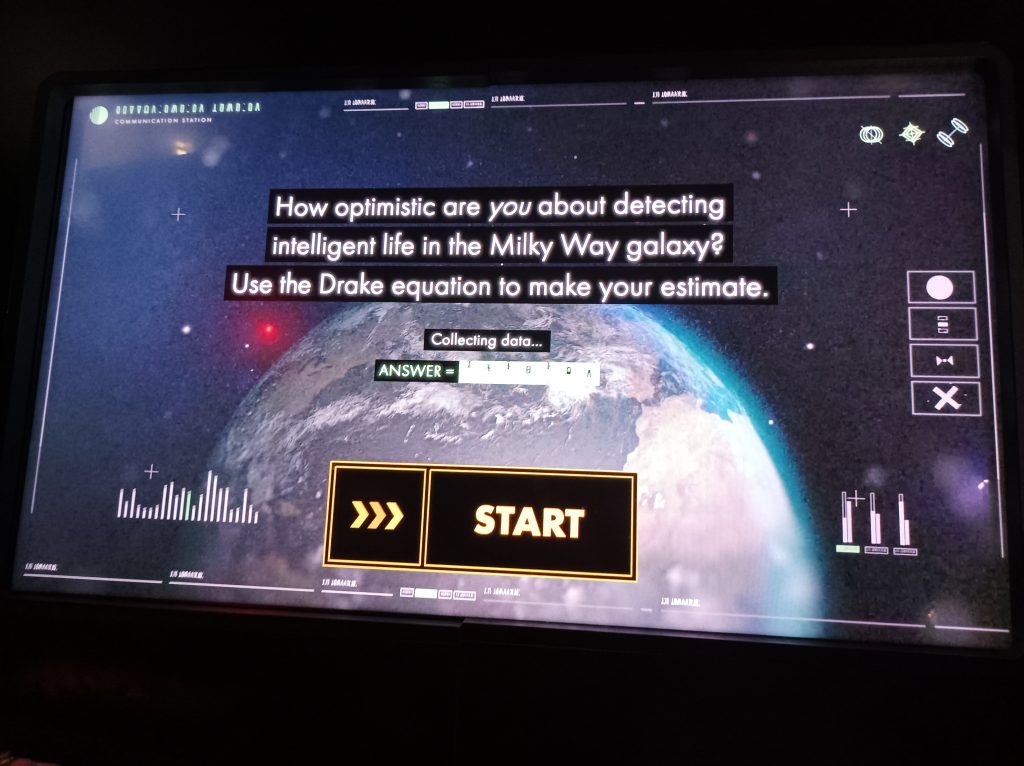
Drake Equation test
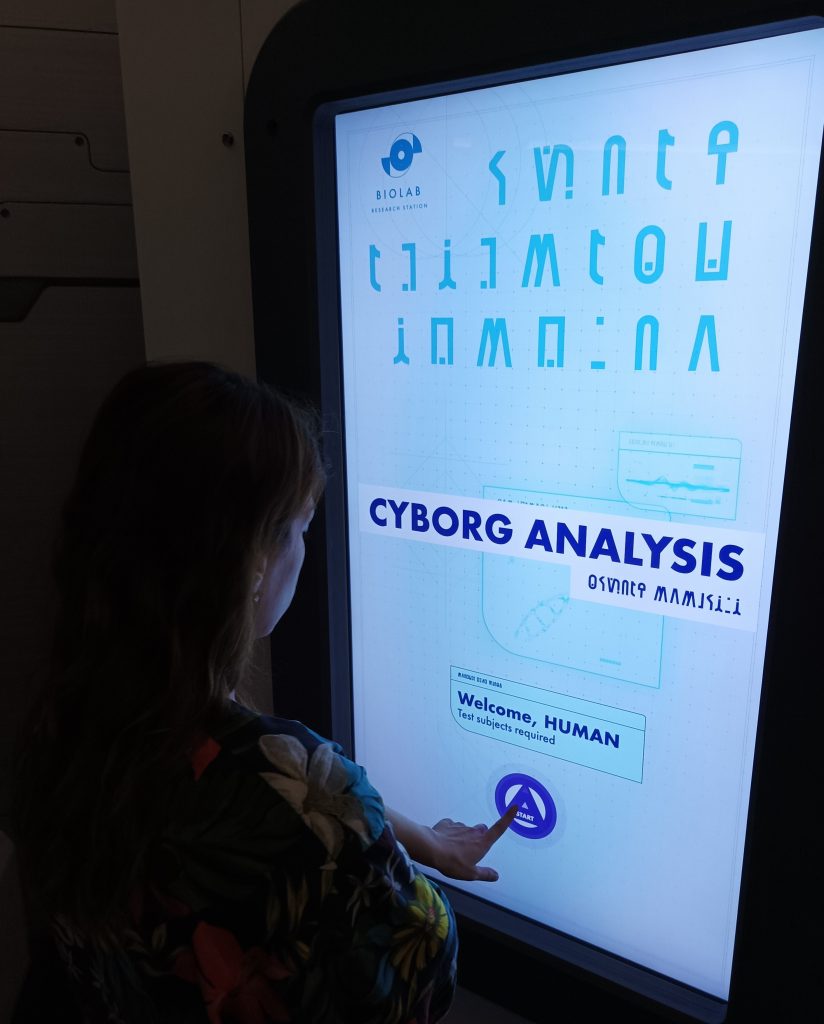
Cyborg Analysis test
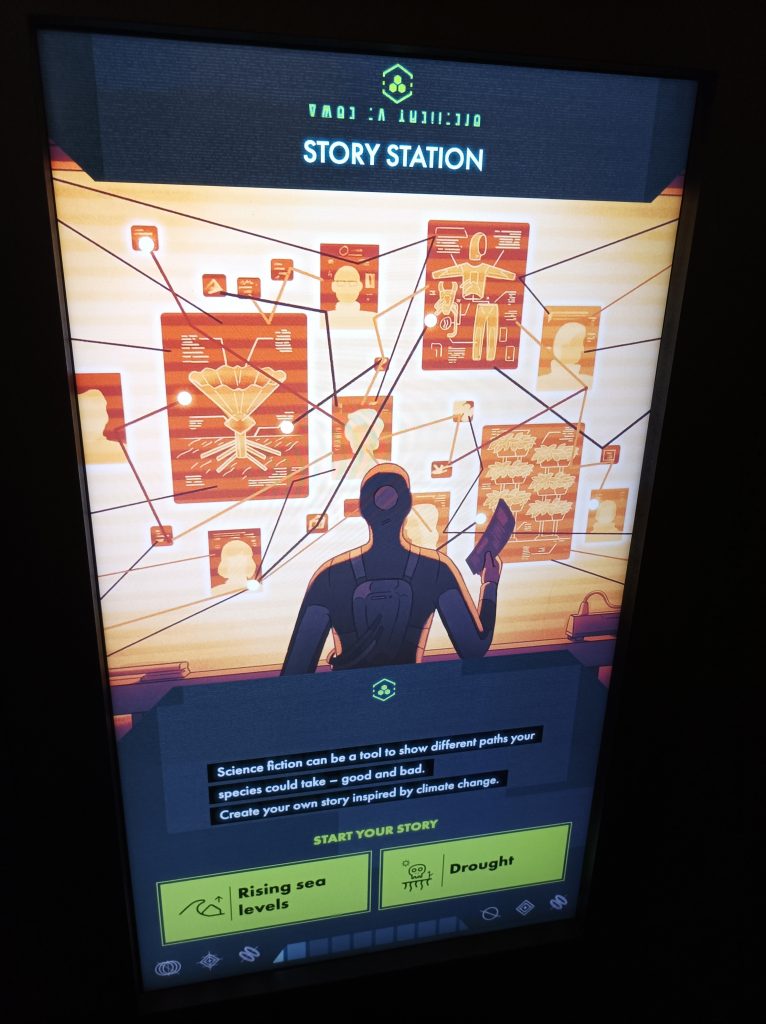
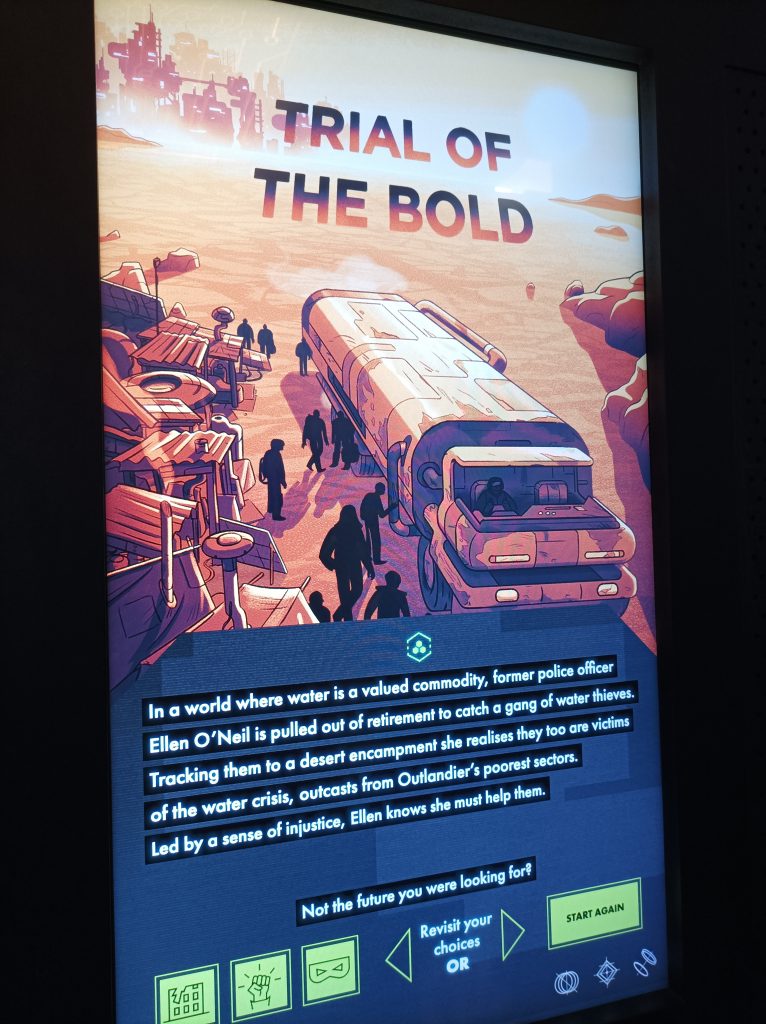
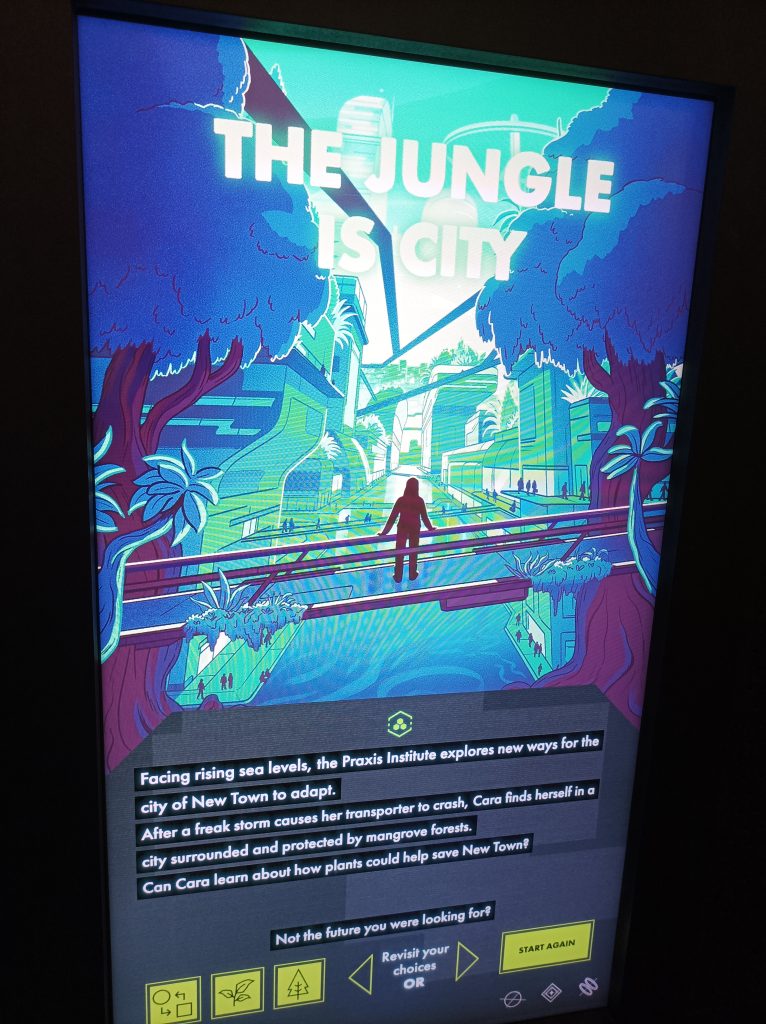
One of the most interesting and richest museums in London, both in terms of the quality of the active exhibitions and the permanent exhibition, as well as the interactivity intended for the youngest. The beginning of science museum begins with the Energy Hall, which presents the development of steam machinery, and turbines and their contribution to the British rise in the 19th century, during the industrial revolution. It is possible to see the original creations and apparatus that pushed the British and their industrial power by developing factories, improving the work efficiency in the mine, and developing the railway. Within this work, there is an exhibition dedicated to the father of the steam engine and early industrialist James Watt called James Watt and Our World.
Then we come to Exploring Space, a space in which the exploration of the expanses of space, the development of the atomic age in the 50s, and, finally, the space race are vividly displayed, and visitors can see replicas of various space capsules and learn more about life in a rocket and what elementary human actions look like in a weightless state.
The Making the Modern World gallery contains models and replicas of the innovations, vehicles and machinery that have propelled mankind from 1750 onwards – here you can see Stephenson’s Rocket locomotive, Ford Model T, Apple I computer, Russell Reynolds‘ X-ray machine, Vickers Vimy aircraft, early models of streetcars, pick-up trucks, stagecoaches, proto-mowers, Lumiere‘s cinematograph, Cray-1A supercomputer and various communication and IT devices, among other things.
On the first floor, there are interactive galleries for children called Engineers and Technicians, where the youngest ones can find out which occupations today most match their interests and they can also try first-hand, on several practical tasks, what it’s like to be an engineer or technician in various environments, a chemist in the laboratory, a digital video artist or a film worker. As I walked through this section, I felt like playing with all these ‘toys’ but I soon became uncomfortable taking a place in line with significantly younger children with their parents. Still, having something like this in a free museum is something that should exist in absolutely every country, if not city, in the world. As much as it is utopian, it is so much necessary for the development of a better society with more interested youth who get an excellent insight into what certain professions look like, and that it is adapted to their age and answers at least some of their questions.
There we come to two larger galleries, and within there are exhibitions dedicated to medicine – Medicine and Bodies, Medicine and Treatments, Medicine and Communities, which deal with the development of medicine, medical procedures, technology, and equipment. Visitors here can see the equipment used in hospitals and operating rooms over the centuries, then the development of technology, scanners, devices, and diagnostic equipment. You can learn more about major milestones such as blood transfusions, discovery of antibiotics, development of vaccines, etc., and the objects on display explain how certain procedures, such as operations, dissections, and autopsies, have been carried out throughout history, and what blood and urine test analyzes look like, virus visualization and other procedures.
A special gallery was related to the work of pioneers in the field of medicine and replicas of their equipment. Considering that most of the names are quite unknown to the general population, and as it was interesting for me personally to learn and connect it all in one place without having thought about it more widely before, I will list here most of the people responsible for the improvement of medicine throughout history, although in principle quite extensive (so feel free to skip this part if you are not interested):
- Thomas Lewis (pioneer in the use of ECG)
- Peter Mansfield (invention of the magnetic resonance imaging device, MRI)
- Ian Donald (diagnostic use of ultrasound in obstetrics)
- Sisters Florence and Edith Stoney (use of radiology and portable X-ray machine on the battlefield during World War I)
- Brothers William and John Hunter (leading surgeons and anatomists of the 18th century who started the school of anatomy, in addition, saw the importance of dissection for scientific purposes)
- Manuel Garcia (invention of the laryngoscope)
- Joseph Lister (use of antiseptics during surgery)
- George Papanicolaou (invention of the pap test and work in the field of cytopathology)
- Theodor Schwann (father of cell theory)
- Louis Pasteur (pasteurization and suppression of bacteria in food and drink and general successes in the field of bacteriology, as well as the development of vaccines for rabies, anthrax, diphtheria, etc.)
- Carl Wunderlich (a pioneer in disease sampling according to body temperature and fever)
- Daniel Gabriel Fahrenheit (pioneer of precision thermometry and father of the Fahrenheit temperature scale)
- June Alameida (pioneer in visualizing and suppressing viruses using the electron microscope)
- Franz Joseph Gall (pioneer in neuroanatomy and mapping of the mental functions of the brain, father of the later proven pseudoscientific method of phrenology)
- Scipione Riva-Rocci (improvement of sphygmomanometer for cardiovascular research, fight against tuberculosis)
- Married couple William Gray Walter and Vivian Dovey (work in the field of neuropsychology and cybernetics, invention of an electronic autonomous robot)
- Augustus Waller (recording of the first electrocardiogram)
- Gregor Mendel (pioneer of genetic research)
On the second floor, the first exhibition we visited was The Clockmaker’s Museum, which thematizes the importance of making antique clocks and preserving the skill of clockmaking from the beginning of the 17th century, from the founding of The Worshipful Company of Clockmakers to the present day. Even more interesting was the exhibition Science City: 1550 – 1800, which, through the prism of scientific and navigational innovations combined with sociological, artistic, but also military, imperial, and colonial efforts shows the transformation of London from the main port and trade center of England to the level of a world financial, but also scientific and artistic metropolis.
Then came the exhibition about the importance of mathematics (laconically called Mathematics) and its interweaving with every aspect of life, from war and peace to life and death, trade and economy, art and architecture. The exhibition, set up in the Winton Gallery and designed by the Zaha Hadid architectural firm, shows the interconnectedness of mathematics and climate change, the betting industry, lotto games, then the robust energy and oil industries, oceanographic research, measurement, etc. Also, inventions such as the first ATM (automated teller machine), Enigma and other devices for encrypting messages, calculator for reinforced concrete, electric logic device, etc. A particularly interesting exhibit here was the Cabinet for Foreign Weights and Measures from the beginning of the 19th century, which was important to British diplomatic missions around the world as a reference for understanding different measurement systems at a time when the importance of international trade was growing significantly and there was a need for standardization and more precise conversion of resources.
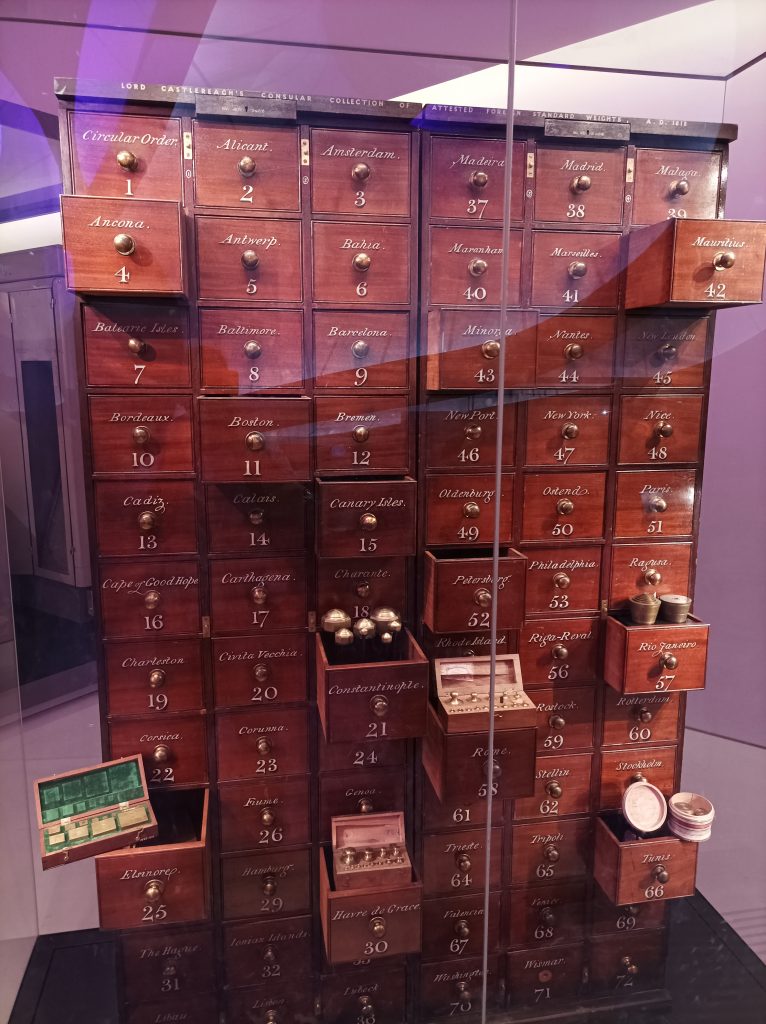
Cabinet of Foreign Weights
Finally, we came to the Information Age exhibition, which follows the development of communication systems, from the telegraph to modern technologies. One of the exhibits that introduces us to the exhibition is the proto-computer of the father of computers, Charles Babbage. In this extremely complex gallery, through six ‘networks’, the history of communication technologies is presented:
- cable – transmission of information from point to point via telegraph stations in the form of electrical impulses.
- transmission/broadcast – the use of radio waves to send information simultaneously to several recipients via television and radio, via a transmitter.
- exchange – Telephone networks convert speech into electrical or optical signals that are exchanged via a central station.
- constellation – satellite networks transmit information between Earth and space using super high frequency waves.
- network/web – computer networks as large distributed networks that transmit information as electrical signals, radio waves, or pulses of light.
- cell – mobile networks use a series of base stations arranged in a cellular pattern allowing mobile devices to be in constant contact.
Within this gallery, it is possible to discover more about the historical development of all six methods of information transmission, see some physical models of devices and general techniques, learn a bit more about the pioneers of each field, and also play – I found the interactive game where, based on what was learned in 160 days, in the year 1984, I had to connect the mobile network better than the competitor, i.e. achieve 100% signal coverage.
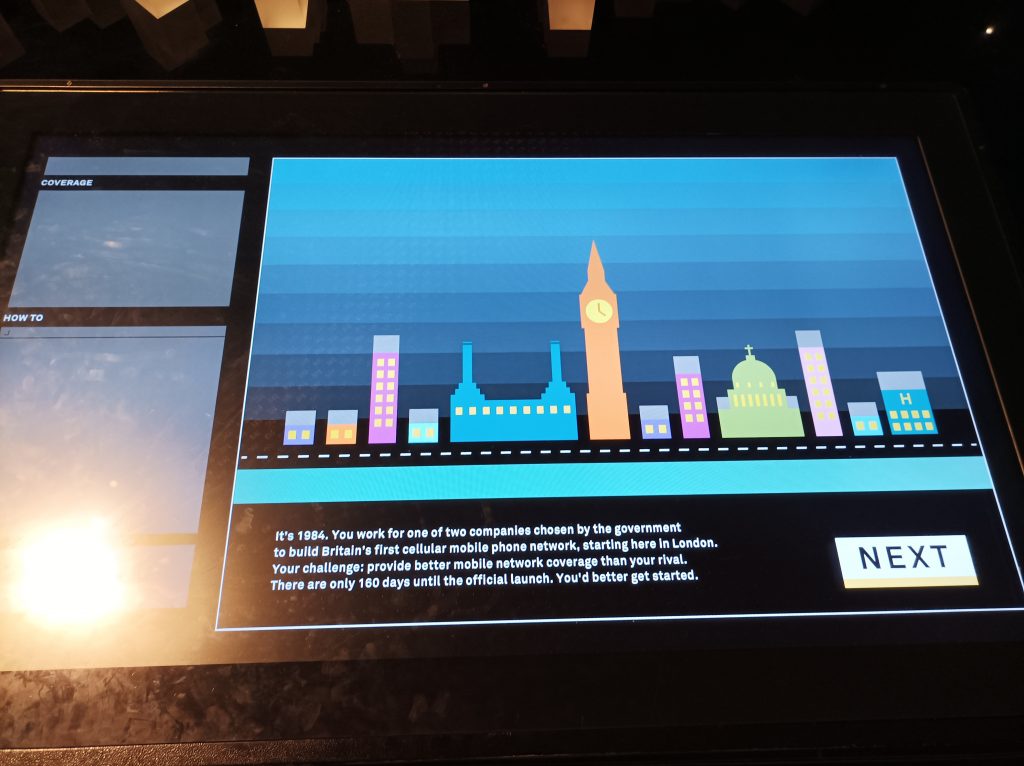
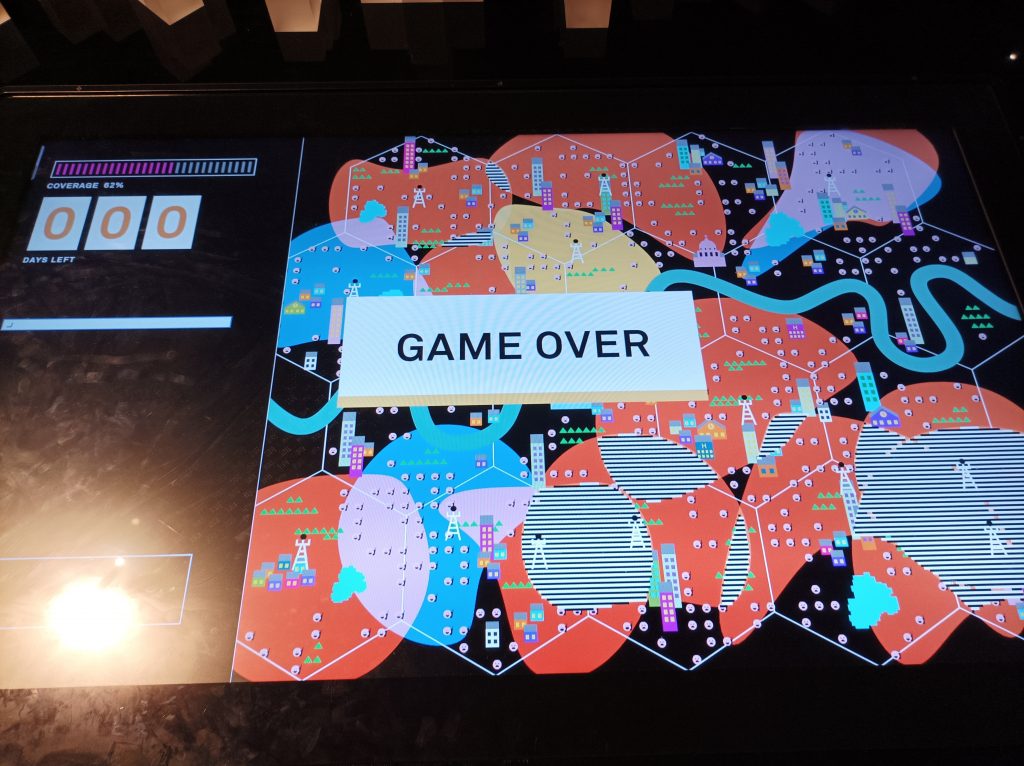
Tate Modern
While Tate Britain is mainly focused on specifically British art, Tate Modern is dedicated to (post)modern art. It was opened in 2000 in the building of the power station, known as Bankside Power Station, but during the renovation, the industrial ambiance of the space was preserved.
Some artists whose works are represented in the museum, which in addition to paintings also contains numerous installations, are Pablo Picasso, Salvador Dali (whose telephone lobster, unfortunately for me, was on tour on the day of the visit), Joseph Beuys, Mark Rothko, a replica of Duchamp urinal, and a particularly interesting installation is the so-called Babel by Brazilian artist Cildo Meireles, an improvised ‘tower’ built from thousands of old radios that represent a language barrier despite communication and global connectivity.
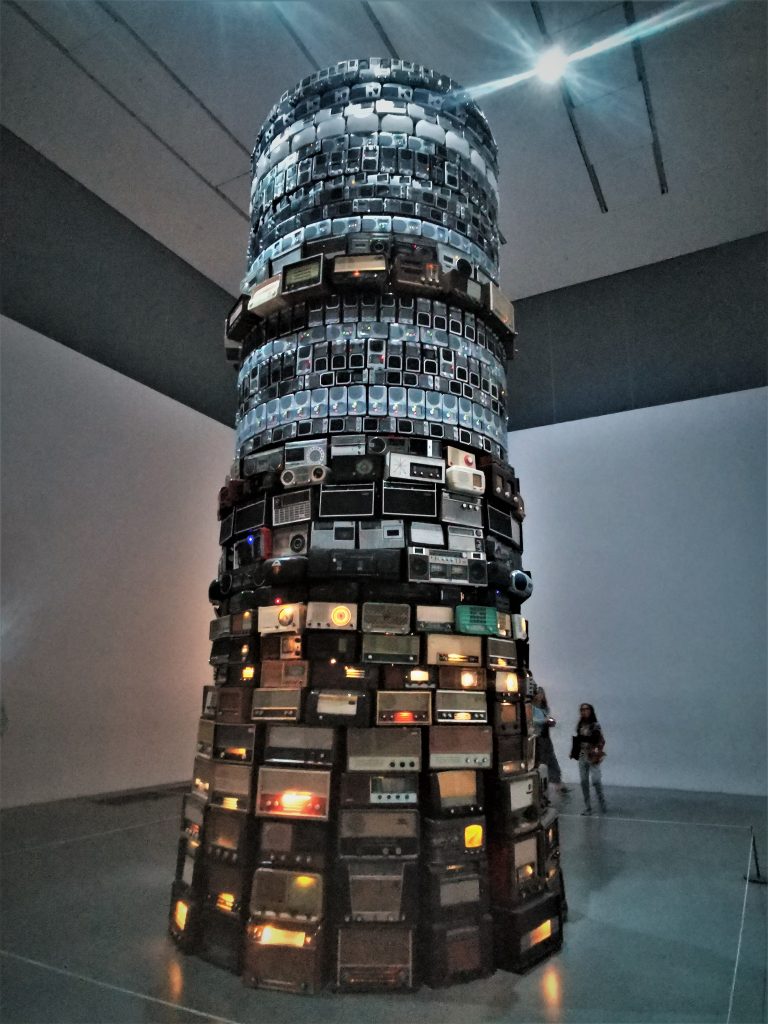
Cildo Meireles, “Babel”
During our visit, one of the chargeable exhibitions we visited was Yayoi Kusama: Infinity Mirror Room. Kusama is a Japanese multimedia artist internationally recognized for her repetitive polka-dot patterns, nets, psychedelic colors, and video art. Despite mental health problems and depression due to which she tried to commit suicide in the 70s, after returning to Japan after living in the USA and France, Kusama became one of the most recognized artists in the world whose work spans through multiple media – performance art, film, painting, sculpture, and poetry.
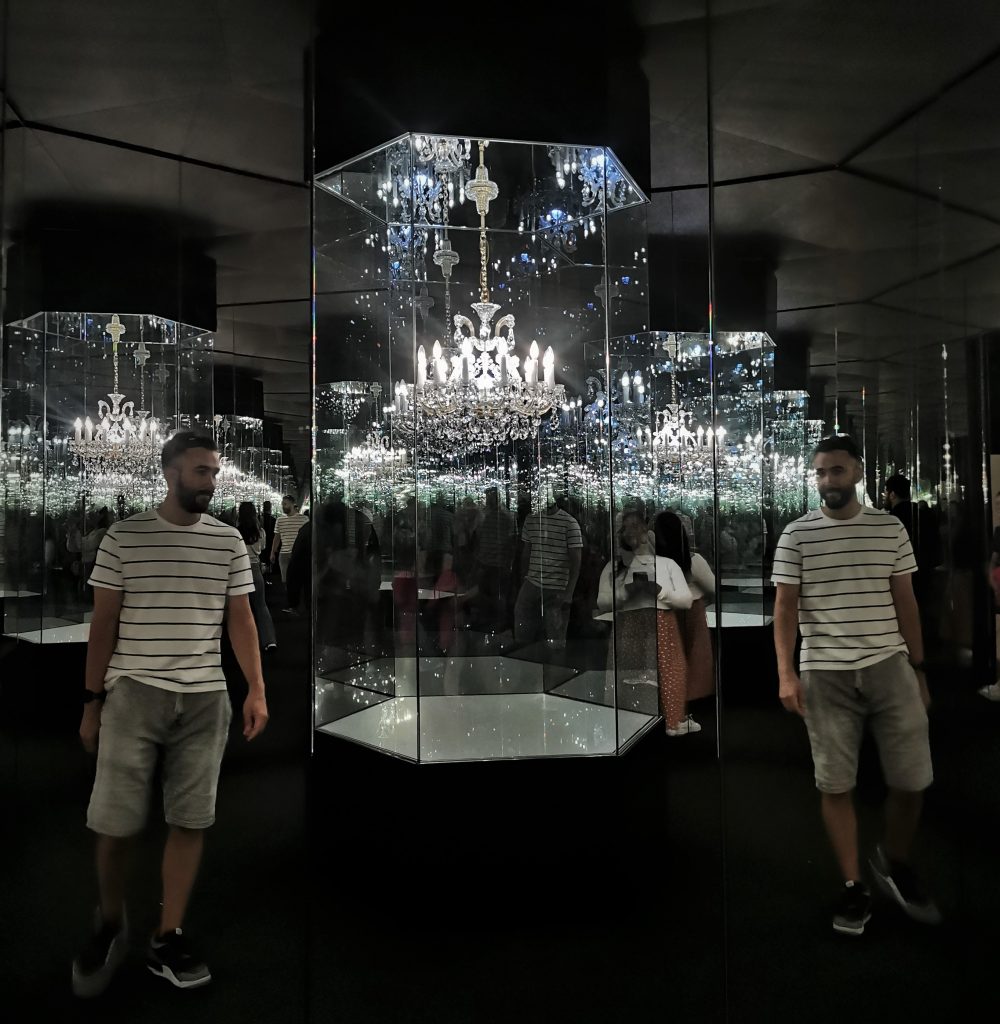
Yayoi Kusama: Infinity Mirror Room
Her Infinity Rooms are a series of mirrored rooms lined with mirrors on both sides, creating the illusion of infinity and the fragility of perception. Inside these rooms, various fractal objects are placed, often glowing or with polka-dot patterns, which seem to repeat themselves endlessly in a mirror reflection, and are an attraction in several world museums where they are placed.
Tate Britain
Tate Britain is one of the four museums in the Tate network of museums, named after the British merchant and philanthropist Henry Tate, a great patron of the arts who donated the initial fund, sufficient to establish the museum in 1897, shortly before his death. At that time, the museum was called the National Gallery of British Art, and in 2000, with the opening of Tate Modern, it was given its current name.
As its name suggests, the collection mainly refers to British art that the museum has been passing through since the beginning of the 16th century, up to the present day. Tate Britain’s exhibition covers a wide range of artistic styles, from portraits and landscapes to abstract and contemporary art. The museum is organized chronologically, with exhibition areas tracing the development of British art through different historical periods. These periods are evoked sometimes through description and sometimes through pictorial expression and current artistic practices.
Some of the most important galleries, apart from the chronology through British art, are a separate exhibition of J.M.W. Turner: Rise to Fame, divided into several sections, which deals with the greatest British landscape painter, along with John Constable. Besides Turner, the works of other famous British artists of the 18th and 19th centuries are exhibited, such as John Everett Millais, John William Waterhouse, George Frederic Watts, Thomas Gainsborough, etc. In addition, one section is devoted to comparisons of the sculptor Henry Moore (“The Three Dancers”) and surrealist painter Francis Bacon (“Three Studies for Figures at the Base of a Crucifixion”), comparing their relationship to the expression and disfiguration of the body.
The works of a few more modern artists are on display – David Hockney (“A Bigger Splash”), Richard Hamilton, Aubrey Williams. What I am very sorry for was the fact that on the day of my visit, the rooms that were dedicated to William Blake, the famous painter and the writer of Romanticism, were closed for renovations and that one of the museum’s most famous exhibits, the painting of the unfortunate Richard Dadd, “The Fairy Feller’s Master-Stroke“, was temporarily removed.
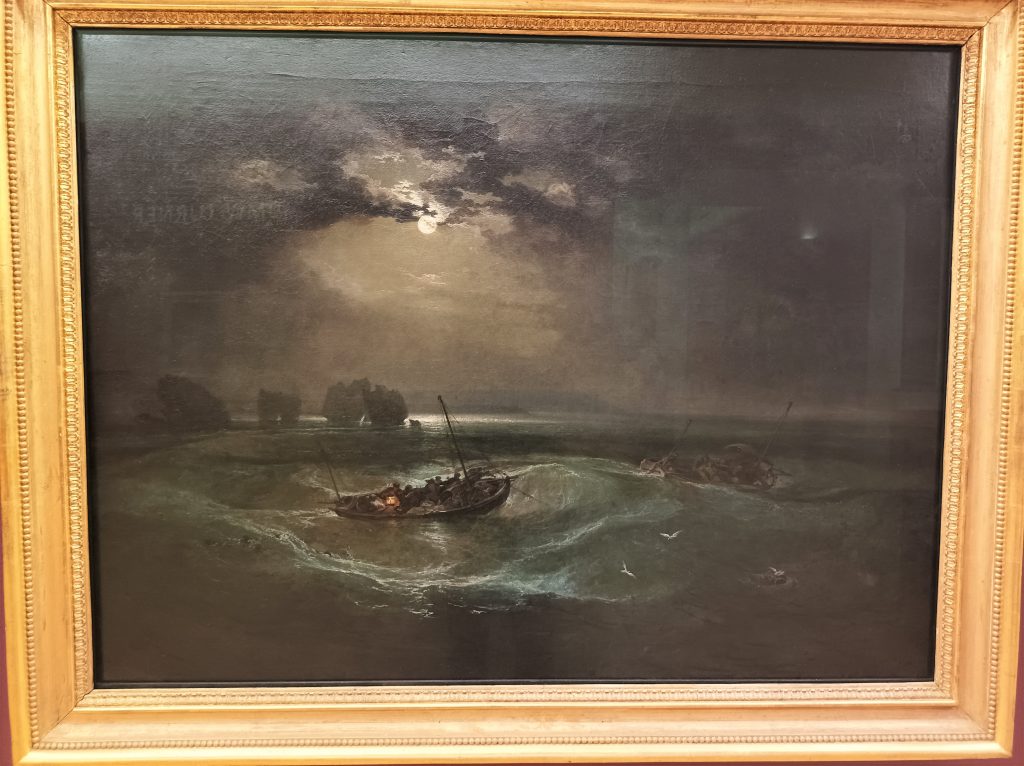
J.M.W Turner, “Fishermen at Sea”
National Gallery
The National Gallery, located in Trafalgar Square in the current building from 1838, contains one of the richest collections of European painting, spanning the period from the Middle Age to the beginning of the 20th century. What is significant is that it is open to public, except for certain paid exhibitions, as it’s the case in most large London museums.
Some of the most famous periods represented in the gallery and associated works are:
- Renaissance: The gallery has significant works by great Renaissance masters such as Leonardo da Vinci, Sandro Botticelli, Titian and Michelangelo. Da Vinci’s painting “The Virgin and Child and St. Anne”, Botticelli’s “Venus and Mars”, Titian’s “Baccha and Ariadne” and the painting “The Epistles” by Hans Holbein the younger are especially famous.
- Baroque: From this period, works by artists such as Caravaggio (“The Murder of St. Matthew”), Rubens (“Samson and Delilah”), Rembrandt (“Self-Portrait as the Apostle Paul”), Vermeer (“Girl with a Pearl Earring”) and Velazquez stand out. (“Venus the Bather”)
- Romanticism and Impressionism: The National Gallery hosts numerous works by artists such as Turner, Constable (“Hay Wagon”), Van Gogh (“Sunflowers”, “Chair and Shoes”), Monet (“Lake of Puddles”) and Seurat (“Bathers in Asnières”).
- Post-Impressionism and Modernism: The collection includes works by Cézanne (“Mont Sainte-Victoire”), Gauguin (“Three Tahitian Women”) and other masters who laid the foundation for modern art.
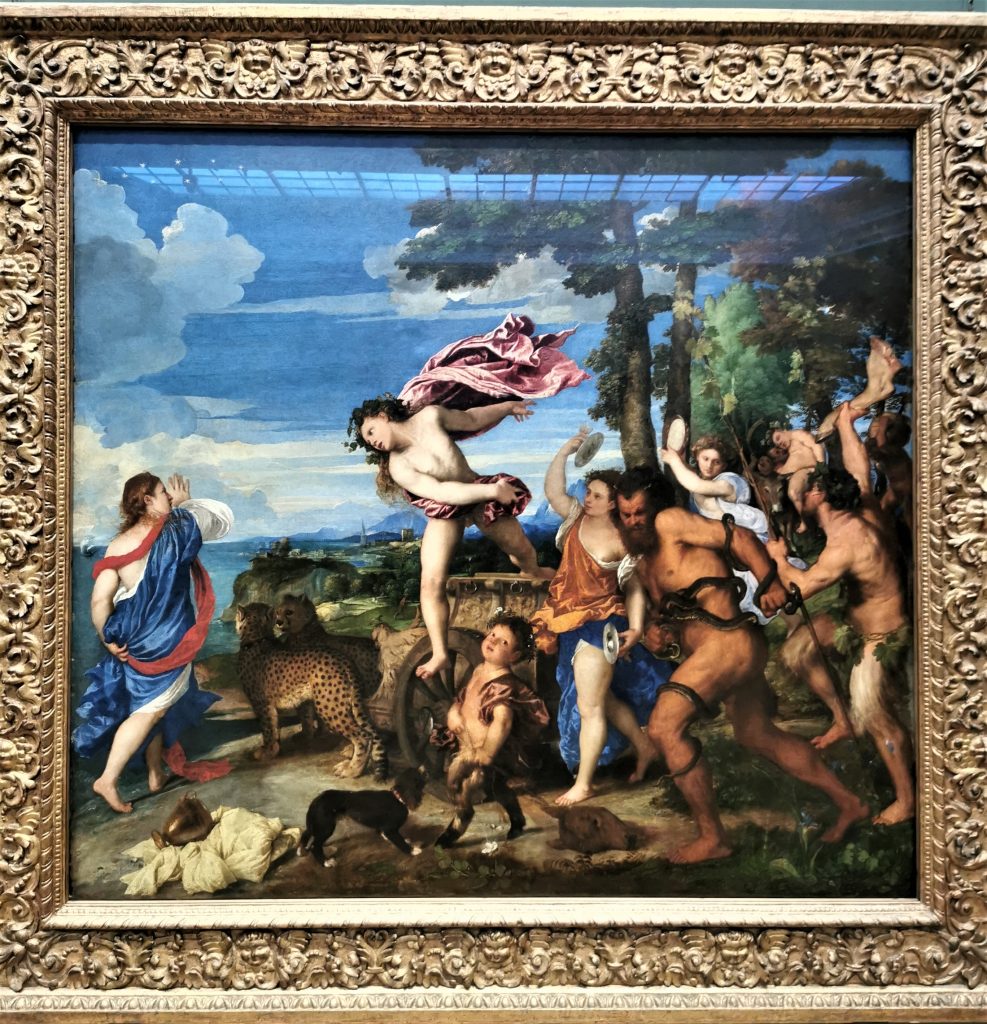
Titian, “Bacchus and Ariadne”
It’s really hard to collect impressions after everything seen and experienced, as well as to conclude this assignment smartly, so I won’t even try. London is one of the biggest tourist destinations, and after almost a week spent there, I can only explain to myself why it is so and wait for the opportunity to meet again.





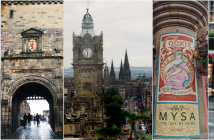
Komentari preko Facebooka